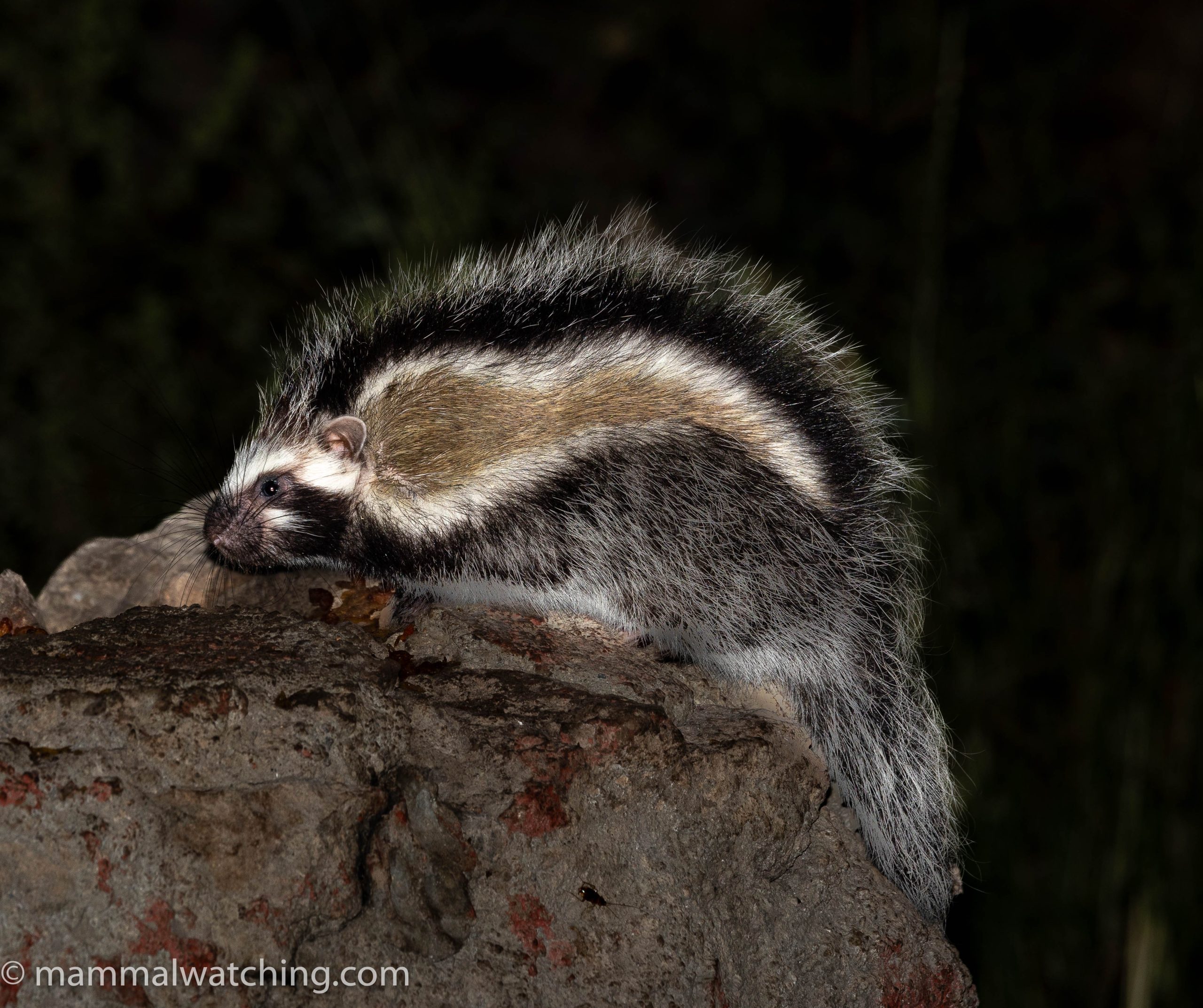
Djibouti, December 2024
Charles Foley, Jon Hall, Alex Meyer and Ian Thompson, guided by Mathieu Mahamoud-Issa
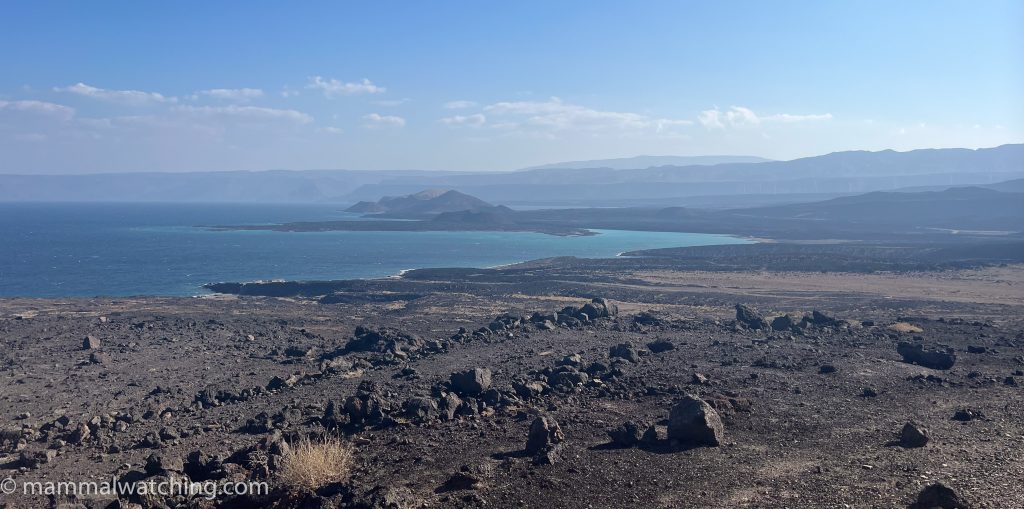
It wasn’t a lot to ask.
Mohamed, our Djibouti ground agent, had been sent three simple requests.
1. Could he meet us at the airport when we landed.
2. Could he buy all our camping food in advance: we wanted to depart immediately.
3. Our food should not contain any fish… a substance Charles and I refuse to eat on principle. The principle being we loathe it.
Such simple requests. And all messed up in breathtakingly fast succession. A remarkable hat trick of failure.
We left the airport and loitered outside the terminal in the gathering darkness for thirty minutes. None of our cell phones worked and as we debated checking into the Holiday Inn a young man came swaggering up the steps. Cue high fives and “hello brother”s … We waited for his apology for being late. But he was not late at all, he explained. “I was in the parking lot organising the car.”
Strike 1.
“Now all we need to do is drive into the city to buy the rest of food you need.”
Strike 2.
“And then we have dinner at a great seafood restaurant.”
Strike 3.
As we drive into the city and the others argued with him about antelope taxonomy, I wondered whether I could safely dispose of his body if I beat him to death with one of the tins of tuna he had surely purchased.
We said a very happy goodbye to Mohamed three hours later. Despite the rocky start the rest of our trip was fabulous as you will read below in Ian Thompson’s report.
Djibouti is going to be the hot new mammal destination for 2025. Or it deserves to be. And remember, you read it here first.
Djibouti or Somaliland?
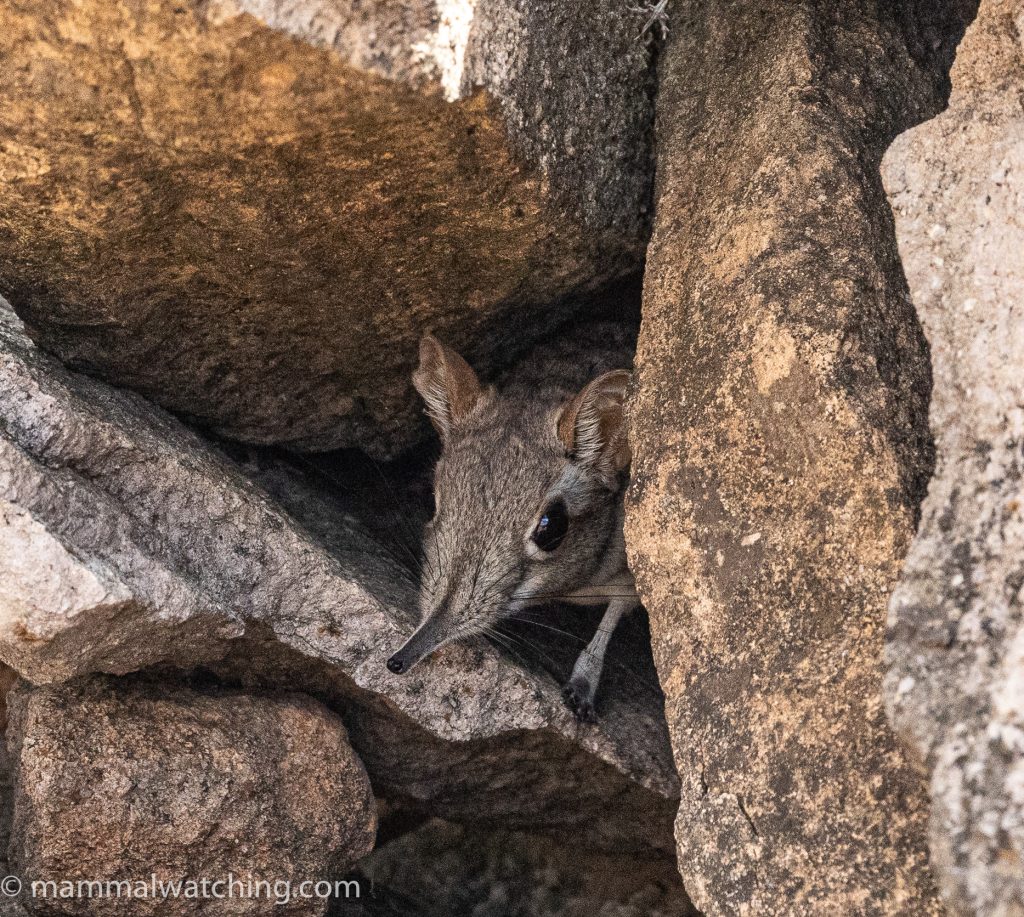
Somali Sengi (Galegeeska revoilii)
When we began organising our trip to Ethiopia’s Somali Region we planned to continue on to Somaliland with our guide Håkan in search of Beira, a rare and beautiful antelope endemic to the Horn of Africa. Somaliland looked interesting, safe and it was reliable for Beira.
All well and good until I realized that Somaliland, a de facto independent state, remains unrecognized by most of the world including the USA. A visit into Somaliland would be treated as a visit to Somalia. Not so well and good for me because Somalia is one of the six countries which the US ESTA travel authorization process asks if you have visited since 2011. If you have visited, for any reason, it seems impossible to get an ESTA and so future visits to the USA would require a visa. Not a problem for my fellow American and Canadian travelers but it would likely become one for me. So my considerate companions agreed that we should look for an alternative Beira destination.
Djibouti was an option. Charles got on the case and figured it all out.
Setting Up A Trip

Assamo Camp.
Djibouti is an easy and affordable country to travel in. It is an adventure for sure but the presence of thousands of French, Japanese, Chinese and American soldiers is oddly reassuring. It may well be the safest place in the world. Though, given the state of global politics in 2025, has the potential to become the flashpoint for World War III I suppose.
I didn’t really know what to expect before we arrived but had a vague image of a hot, flat country covered in dust.
Wrong! The landscapes were dramatic, the weather was pleasant (in December at least) and I don’t remember much dust. And given what we saw of the coastline there must be some fantastic diving.
Although attention to detail was not our ground agent’s strong point he did have an eye for talent. He hired an excellent driver for us with a brand new Landcruiser. Louback Gohar Hamadou is reliable and a lovely guy, based in Djibouti City, and couldn’t do enough for us. He even ferried us to the airport after the tour had finished. He knows the sites we visited and is all you need to follow in our footsteps. You can WhatsApp Louback on +25377877829 and he can set everything up for you including helping with letters for visa applications. Highly recommended
If you are thinking you might self-drive then I would think again. If you are still thinking, then a very solid 4×4 is essential.
Mohamed also hired a cook, Roukya, for half our trip. She too was lovely though in the end she only cooked one proper meal. A meal of pasta full of canned tuna. When she realised Charles and I didn’t eat fish she was devastated. Apparently Mohamed didn’t mention we didn’t eat fish. No surprises there.
If you need a cook then Louback can reach out to her.
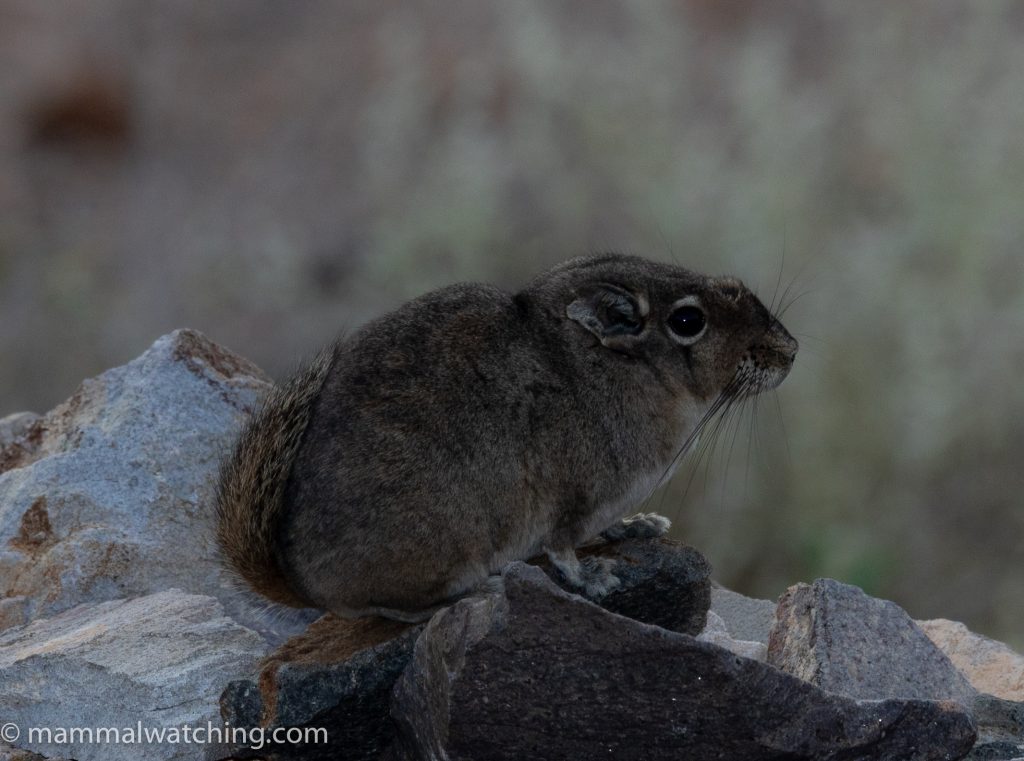
Speke’s Gundi or Pectinator (Pectinator spekei)
We also benefitted enormously from the company of Mathieu Mahamoud-Issa, a local biologist who works for Décan (Association de protection de la faune & de la flore djiboutienne) a local conservation NGO who Charles approached after seeing his Beira photos on Facebook.
Mathieu is a great field biologist, very knowledgeable and an extremely nice guy. He was frighteningly fit and seemed incapable of walking at less than 10 kmh. A speed he maintained effortlessly while giving the illusion that he was taking a slow stroll.
The bad news is that Mathieu is not a guide. He has a full time job and research workload to keep him busy and this trip was a one off.
The good news is that Louback now knows the sites and you don’t really need another guide. You can arrange for a local guide at Assamo who can help you with the Beira, while at Dittilou the camp naturalist can show you the Somali Sengis and – if for some strange reason you are interested – the Djibouti Francolins too.
Itinerary
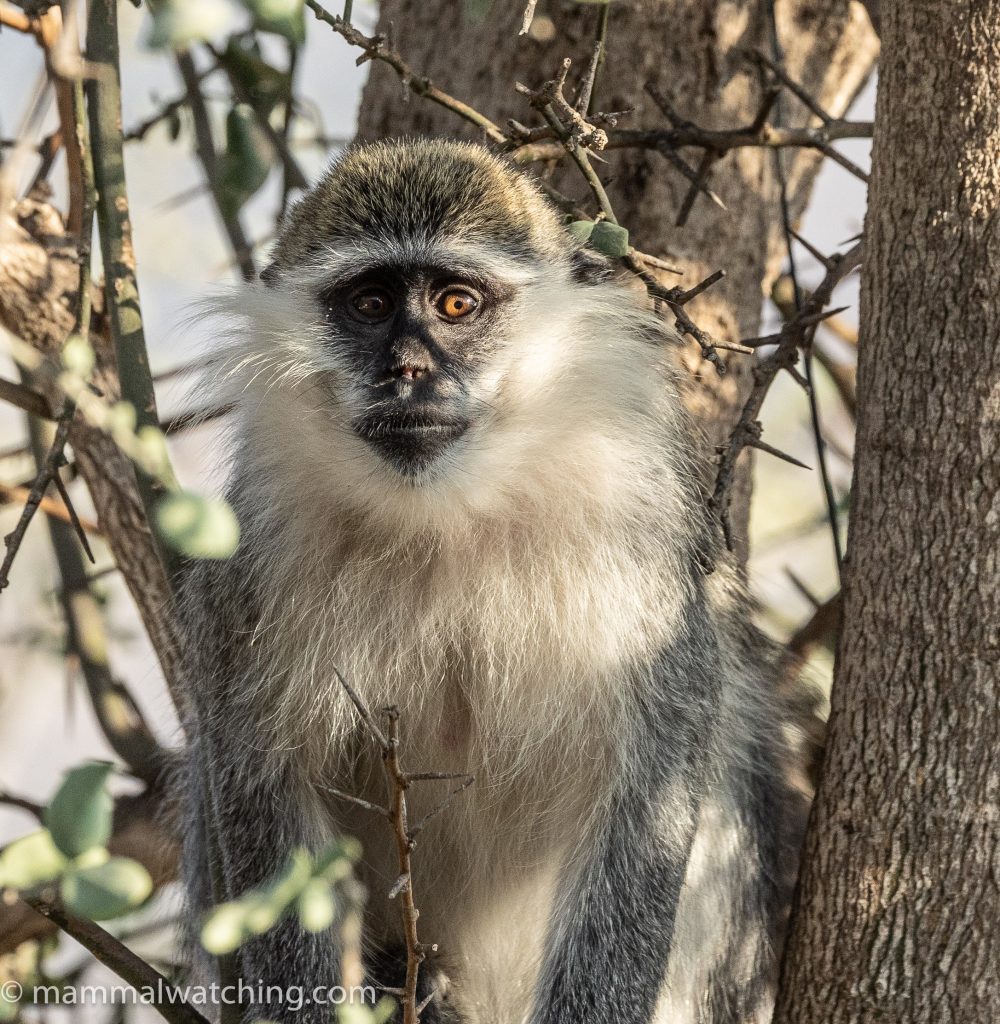
Grivet Monkey (Chlorocebus aethiops)
We spent just four nights in the country. Charles planned our itinerary with the help of Mathieu. We would spend our first night in Décan’s Djalelo Camp, a couple of hours south of the city. We had no particular targets there. From there we would continue south to Décan’s Assamo Camp on the border with Ethiopia. This is the place to see Beira, our key target for the trip. After a night or two here, we would drive north to Dittilou Camp in the Forêt du Day, where we would look for Maned Rat and Somali Sengi. We also held a glimmer of hope of scoring an Abyssinian Genet here. This is a species so rare that it features on re:wild’s most wanted list of lost species, and is known from fewer than 20 museum specimens, only one of which was collected in the past 70 years (in 2016 in the Forêt du Day).
Day 1: Arrive 6pm and drive to Djalelo.
Day 2: Arrive Assamo in mid-afternoon and look for Beira.
Day 3: If we had seen the Beira continue to Camp Dittilou.
Day 4: Dittilou.
Day 5: Return to Djibouti City and depart.
Visas and Flights
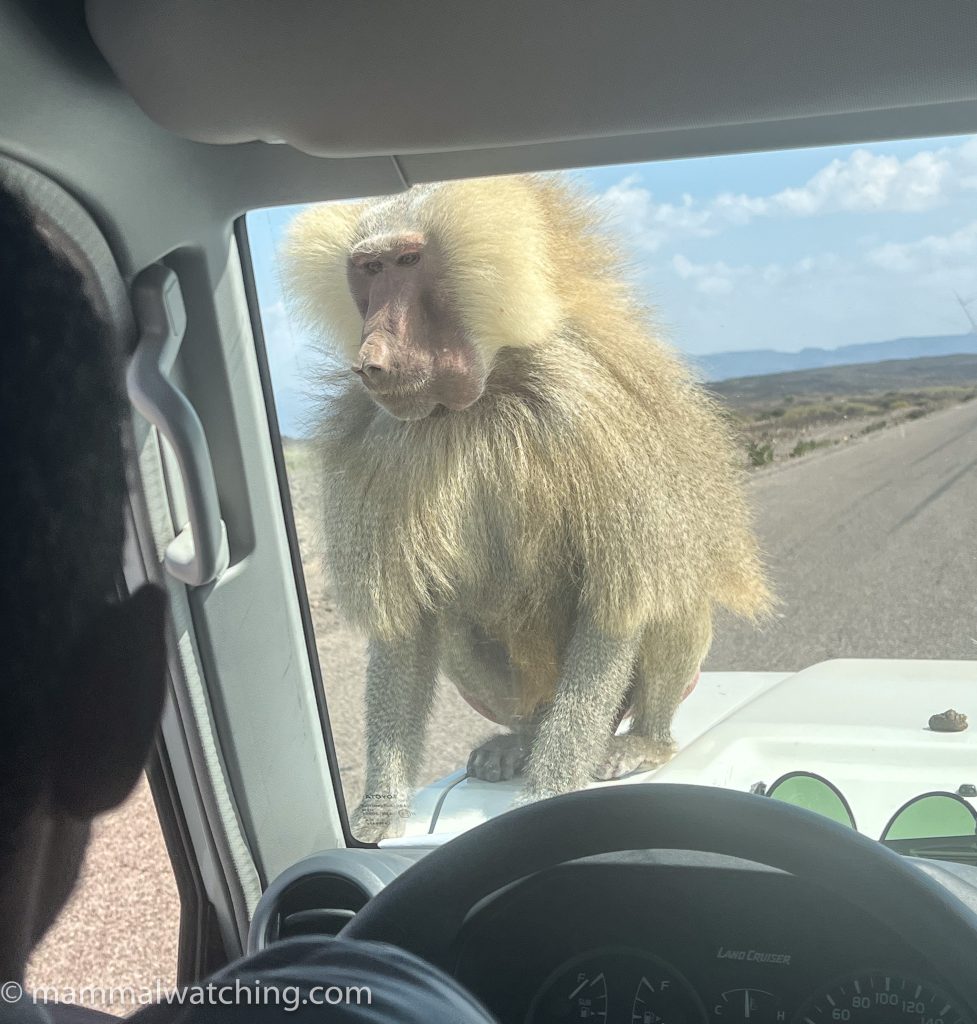
Hamadryas Baboon (Papio hamadryas)
Applying for a visa online is easy and takes a few days. You need some sort of letter of invitation which Louback can provide. We flew direct from Ethiopia on the back of our trip to the Somali Region. This meant we didn’t have our thermal scopes. But both Qatar and Turkish Airlines seem to fly to Djibouti daily, and Air France have a direct flight from Paris once a week.
None of our cell phones worked when we arrived. This is a problem when you are waiting outside the airport trying to find your ground agent. We bought local SIM cards for not very much money at a very fancy mall in Djibouti City.
The Djibouti Big Four
There are a bunch of Tier 2 mammals in Djibouti including Gerenuk, Soemering’s and Dorcas Gazelles, Hamadryas Baboons and Rupell’s Foxes. But in my mind four species are Premier League status. We saw them all.
Beira
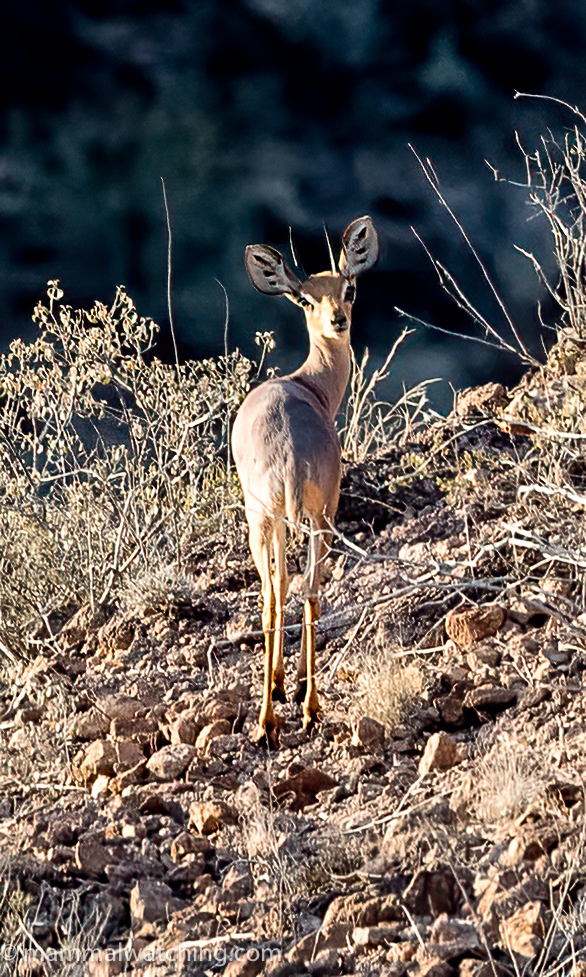
Beira (Dorcatragus megalotis)
This very rare antelope is known only Djibouti, Somaliland and has just been confirmed from Ethiopia. A mega antelope which seems pretty easy to see in Assamo Camp.
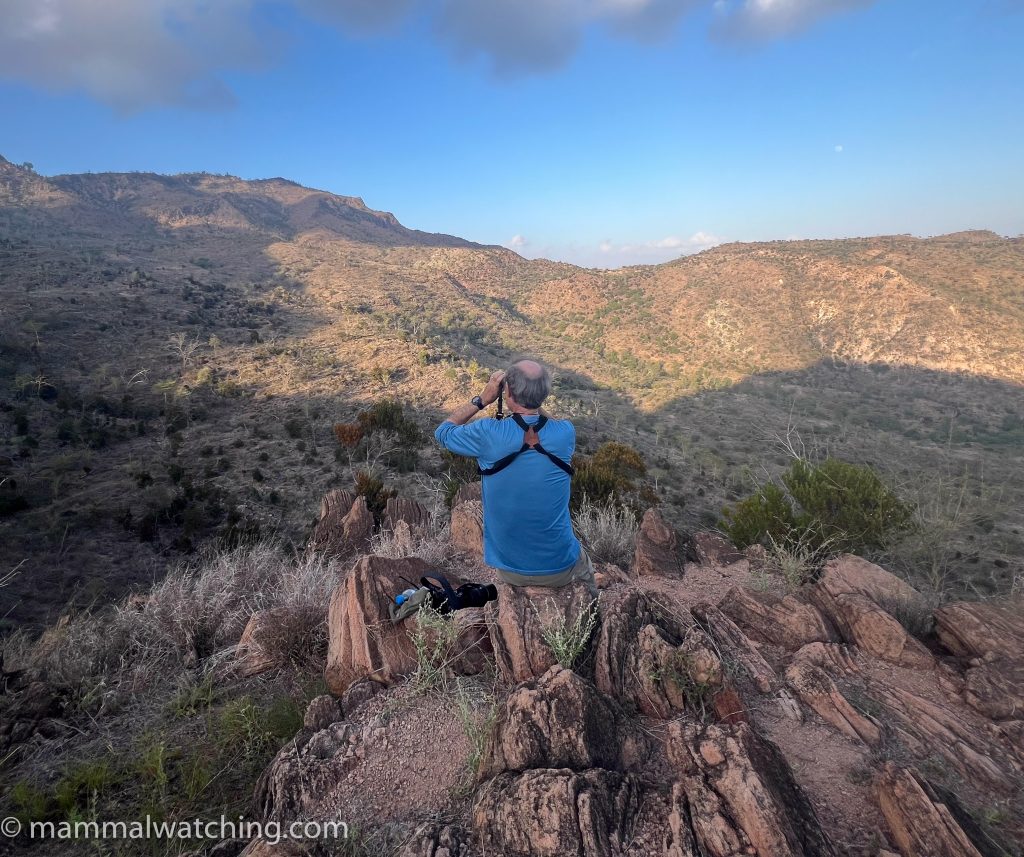
Charles demonstrates his Beira spotting skills
It took us an hour to spot some, We were lucky. But from what we could gather you would have to be unlucky not to find them in 48 hours there.
Somali Sengi
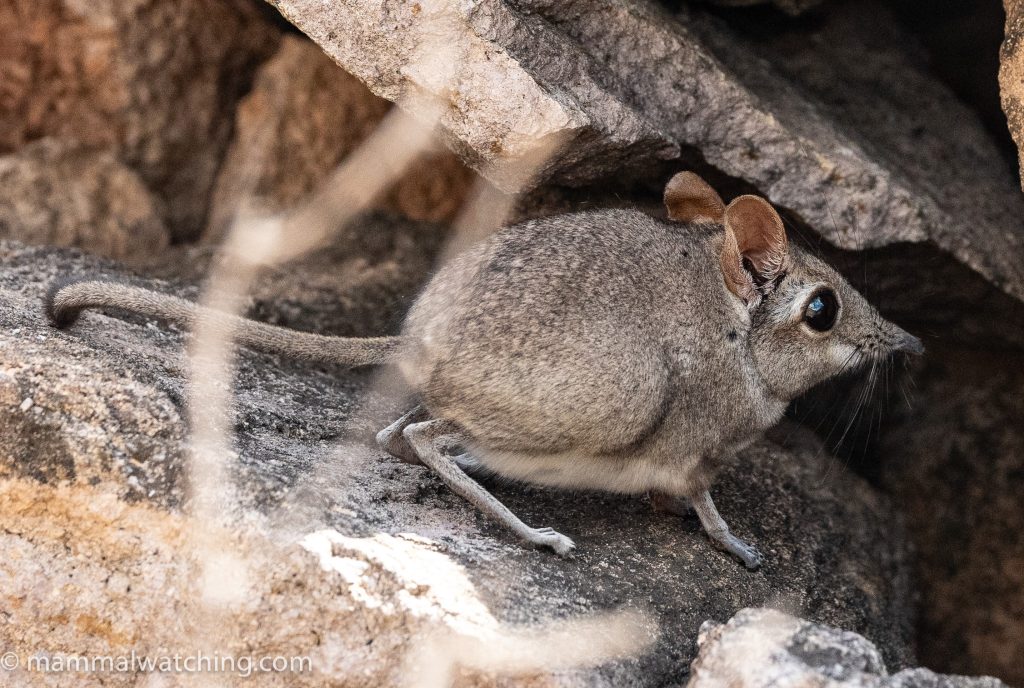
Somali Sengi (Galegeeska revoilii)
This elephant shrew was lost to science for 60 years and only rediscovered in 2020. We looked for them around Assamo Camp without success though they are not uncommon there. We had stellar views of one animal at Dittilou that posed on a rock for 45 minutes and saw several others during our stay.
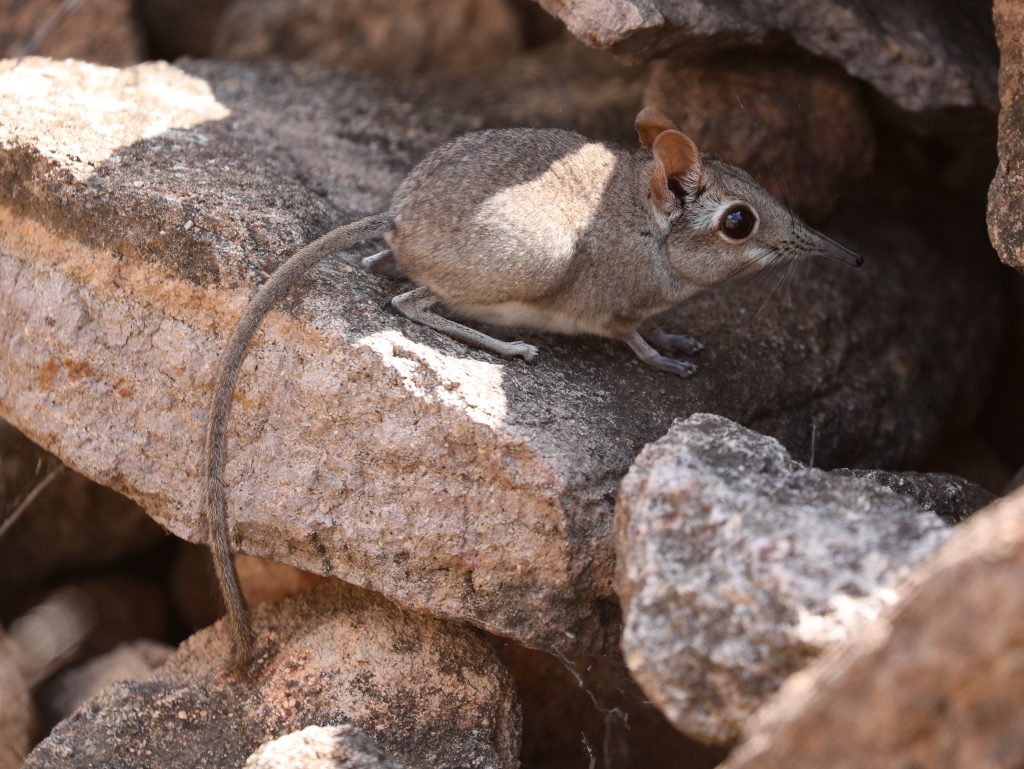
Somali Sengi (Galegeeska revoilii). Photo Alex Meyer.
As I understand it, the species can be distinguished from the parapatric, potentially sympatric I guess, and very similar looking Rufous Sengi by the hairy tail tip of the Somali Sengi’s tail (clearly visible in both photos above) and a tail that exceeds head and body length ‘considerably’.
Maned Rat
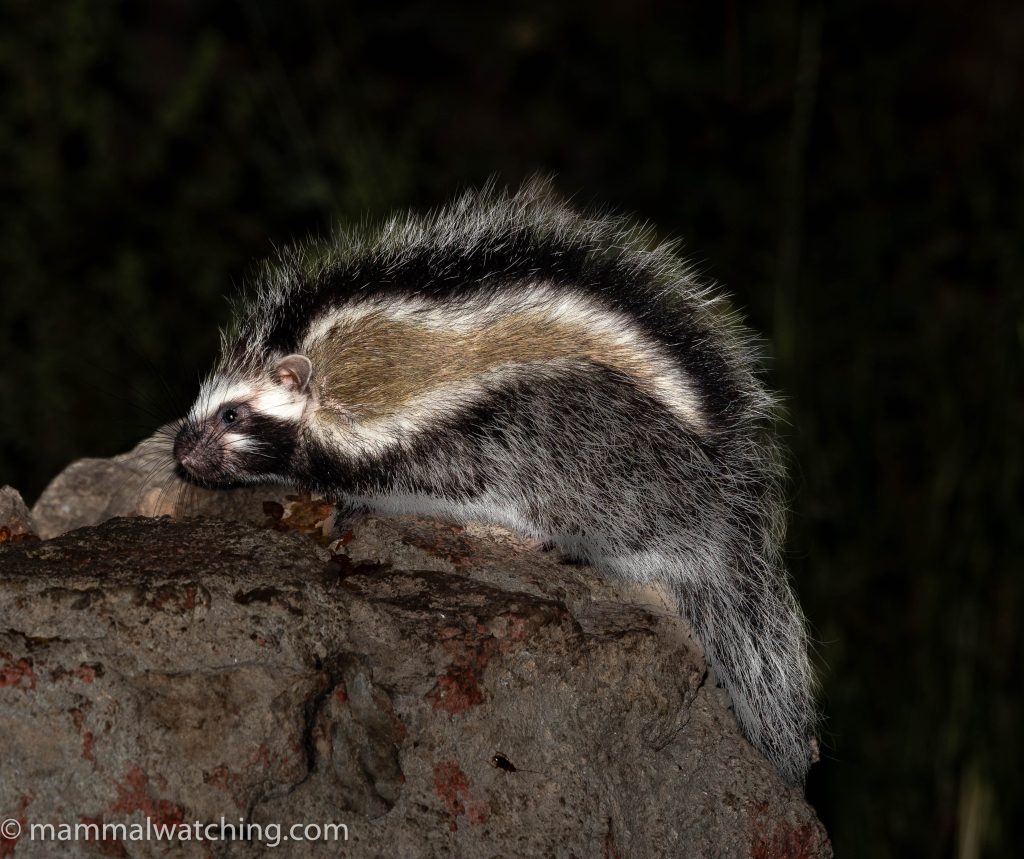
Maned Rat (Lophiomys imhausi)
One of the world’s great rodents – arguably THE greatest rodent – seems reliable at Dittilou Camp. We saw several over two nights, including the animal above that searched for food behind the kitchens at Dittilou.
Abyssinian Genet
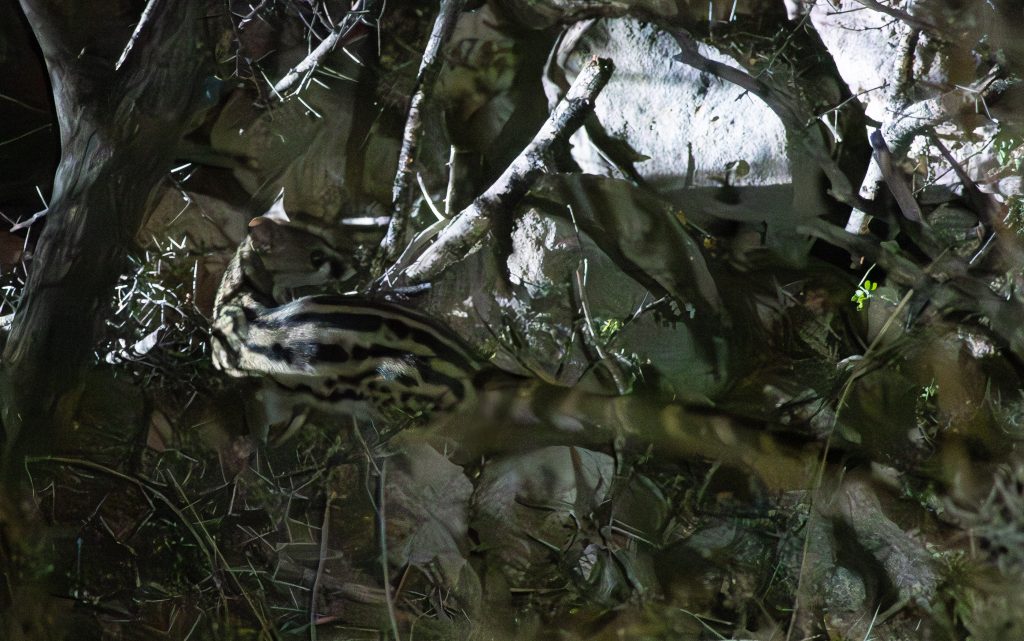
Abyssinian Genet (Genetta abyssinica). Photo Charles Foley.
This was an absolute mega find and one of my top three species for the 2024 (along with Vaquita and Liberian Mongoose). And we took what appear to be the first ever photographs of an animal in the wild.
Indeed, the reason this report took so long to produce is entirely down to me and my belief that our genet pictures ought to make headline news. I mean if a shrew in California makes the CNN home page … Apparently the world wasn’t as excited as me about our genet. Still, finding it was a lot of fun and a perfect example of why mammalwatching is the world’s greatest hobby.
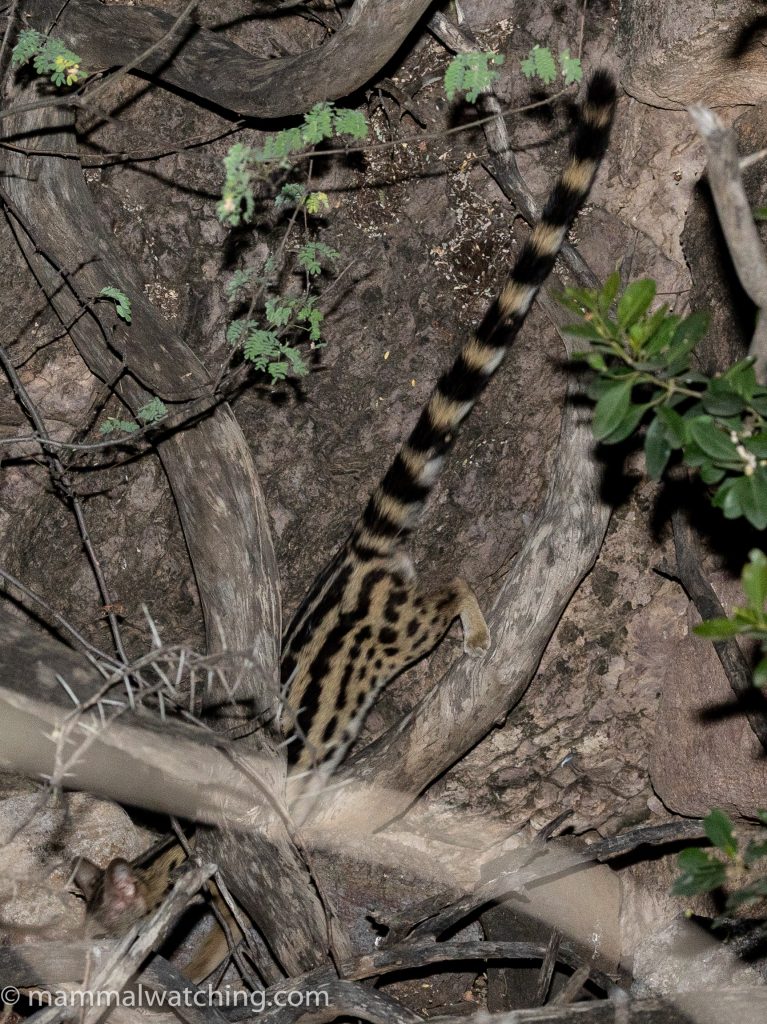
Abyssinian Genet (Genetta abyssinica)
The Ethiopian genet had not been collected for 60 years until – in 2016 – researchers trapped and collected a specimen in the Foret de Day in southern Djibouti. Known from fewer than 20 museum specimens, it is widely considered to be exceptionally rare and I can find no photos of this animal anywhere.
Rare or not, if we got the Beira quickly then we thought we would travel to Dittilou and give the genet a try.
Our optimism got a boost when Mathieu mentioned he had seen images of what appeared to be an Ethiopian Genet on a camera trap from the Forêt du Day. That boost evaporated as we arrived at our camp: the camera trap site was a day’s walk away.
With only two nights to search we asked around camp. Someone said that he often saw genets on the hill behind the camp’s kitchen. This was no great surprise given Common Genets were almost certainly in the area. But when he explained that some of the genets looked different to the others our collective pulse quickened. Game on!.
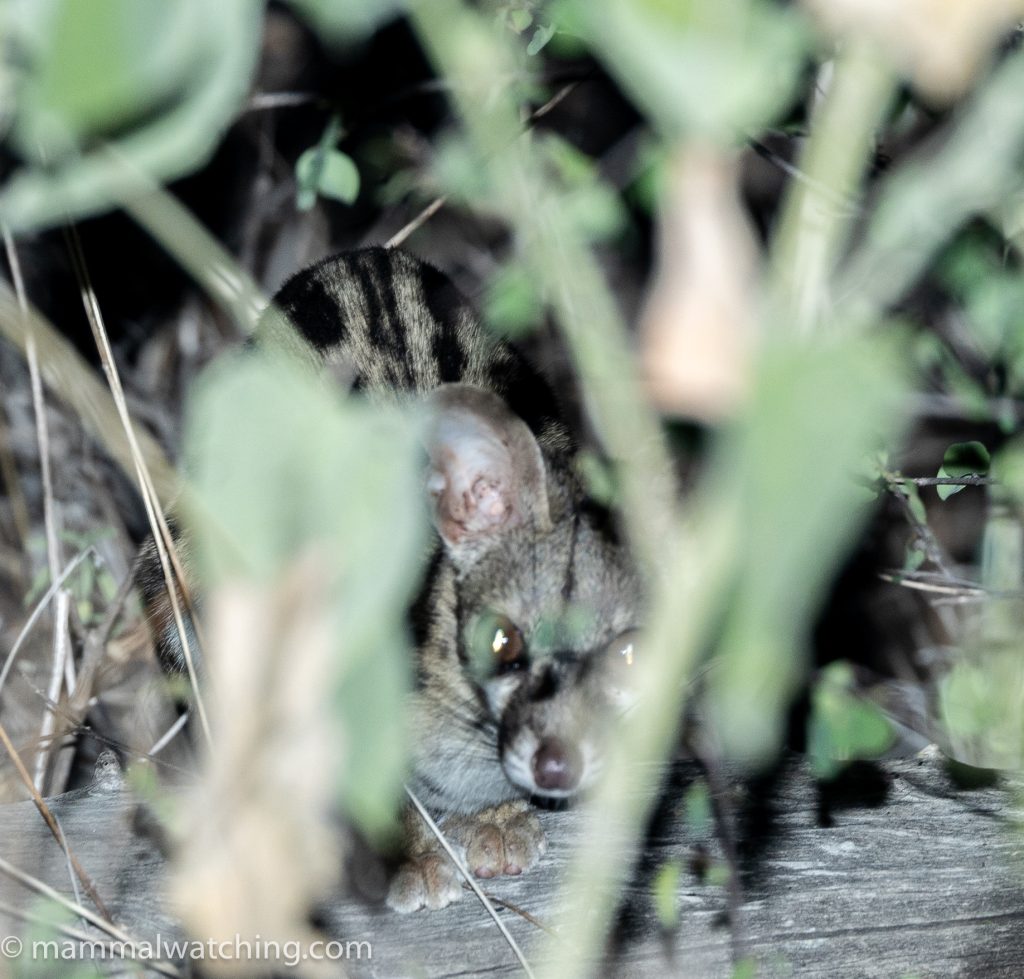
Abyssinian Genet (Genetta abyssinica)
Just two hours after dark on the first night we caught a glimpse. But only Charles saw the animal well enough to be sure it was an Ethiopian Genet: he saw the striking dorsal stripes that separate this species from the Common Genet.
His view was only for a second or two. No chance for photos.
We returned the next night. It didn’t take long for Charles (again – always Charles) to spot a genet. The animal was very shy and we followed it on foot for almost an hour until we were able to see it clearly for a few seconds. We had the photos that proved we had found our target.
‘Euphoric’ doesn’t really cut it.
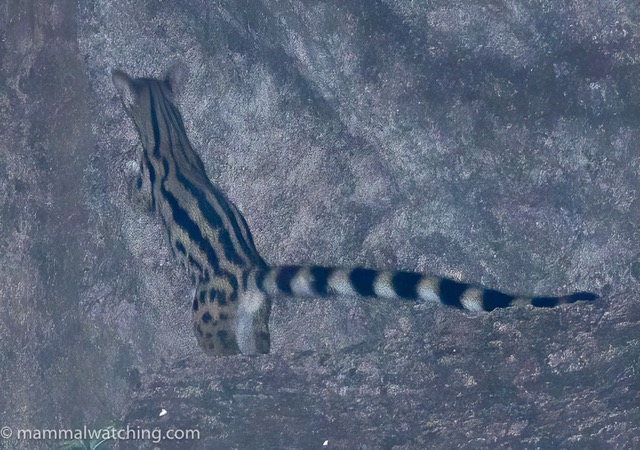
We saw the same animal thirty minutes later higher up the hill side, in the open and climbing a small cliff face, but just a bit too distant for good photos.
More details will be in a forthcoming journal note. Perhaps then the world’s media will realise they are missing the scoop of the century!
And now for Ian’s report.
Trip Report
Ian Thompson
What makes for a great trip? Opinions vary, but epic landscapes, rare and unusual wildlife and good company are surely some of the major components.
Our recent trip to Djibouti had all of these elements and more. Following a week in the Somali region of Ethiopia, Jon Hall, Charles Foley, Alex Meyer and I flew from Jijiga to Djibouti via Addis Ababa. We arrived as scheduled at about 5:30 pm. Our local fixer, Mohamed, was nowhere to be seen as we stood outside what is surely one of the smallest international airports in the world. After a call from Charles, Mohamed arrived with a hearty “Hey guys” greeting, claiming that he had been making arrangements for our trip from the parking lot. As I had assumed these arrangements had been made some time previously this was not particularly reassuring. We piled into the back of a new Land Cruiser and Mohamed suggested we go to a local fish restaurant for dinner. Jon and Charles reminded him that they don’t eat fish, to which he replied that they also had beans and meat there. We picked up our guide, a researcher named Mathieu, and a cooker which Mohamed had purchased earlier. As we entered the restaurant, the proprietor was holding up a large fish from the freezer, which appeared to contain nothing other than fish. True to his word however, the restaurant did have bean stew with meat and chilies in it which was delicious with fresh flatbread. After dinner and parting ways with Mohamed, we picked up SIM cards and headed for Djalelo, a couple of hours from Djibouti city.
Djalelo
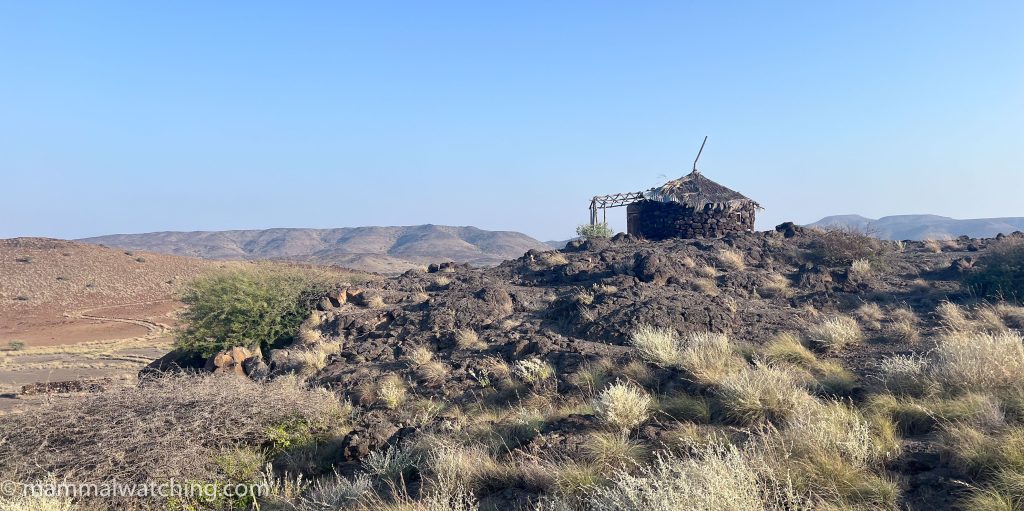
After entering the reserve we drove around on several dirt tracks, seeing Gerenuk, Salt’s Dik-dik, two Crested Porcupines, a White-tailed Mongoose, Dorcas Gazelles, Abyssinian Hare and a gerbil of unknown species.
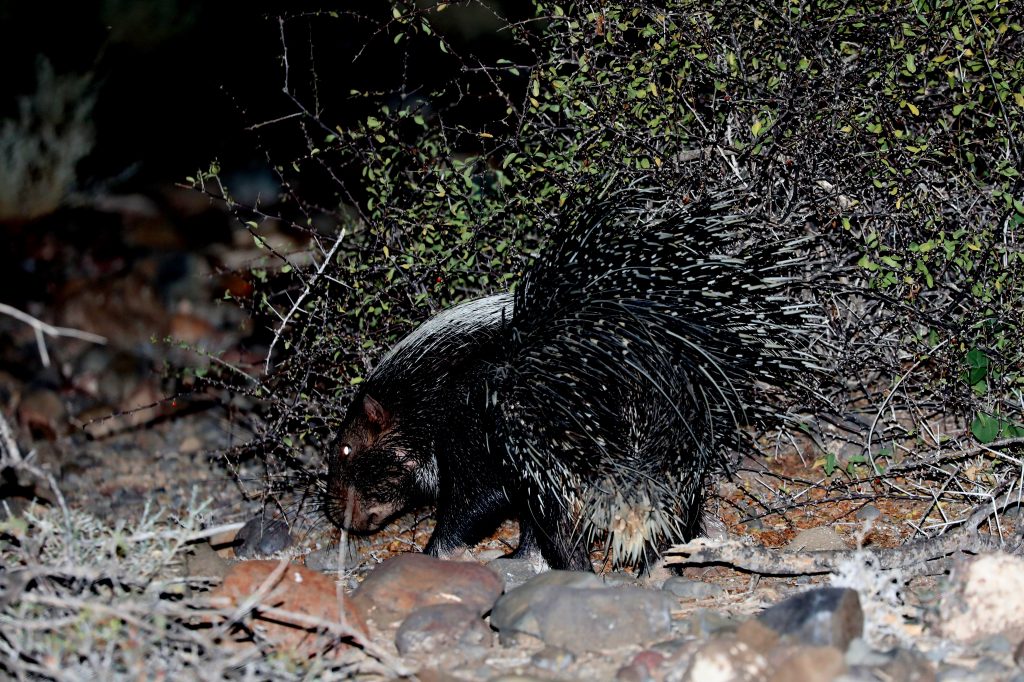
Crested Porcupine (Hystrix cristata). Photo Alex Meyer.
The camp at Djalelo was very rustic but serviceable, consisting of some low roofed stone structures with mattresses inside and a central dining enclosure.
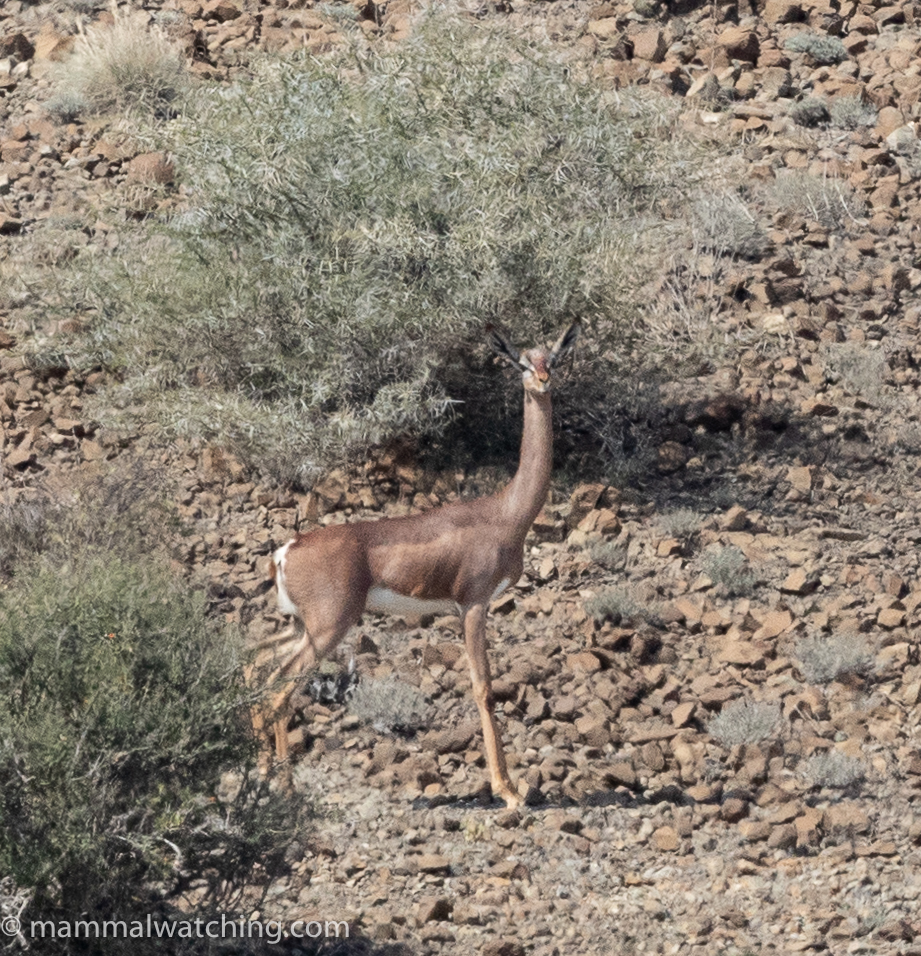
Gerenuk (Litocranius walleri)
We were up early and greeted by a landscape of low hills and sparse vegetation. The shower blocks had functioning toilets and showers, which was unexpected and very welcome. After a breakfast of bread, “Vache qui rit”, jam and peanut butter, we hiked over a ridge behind camp and found a small group of Dorcas Gazelles.
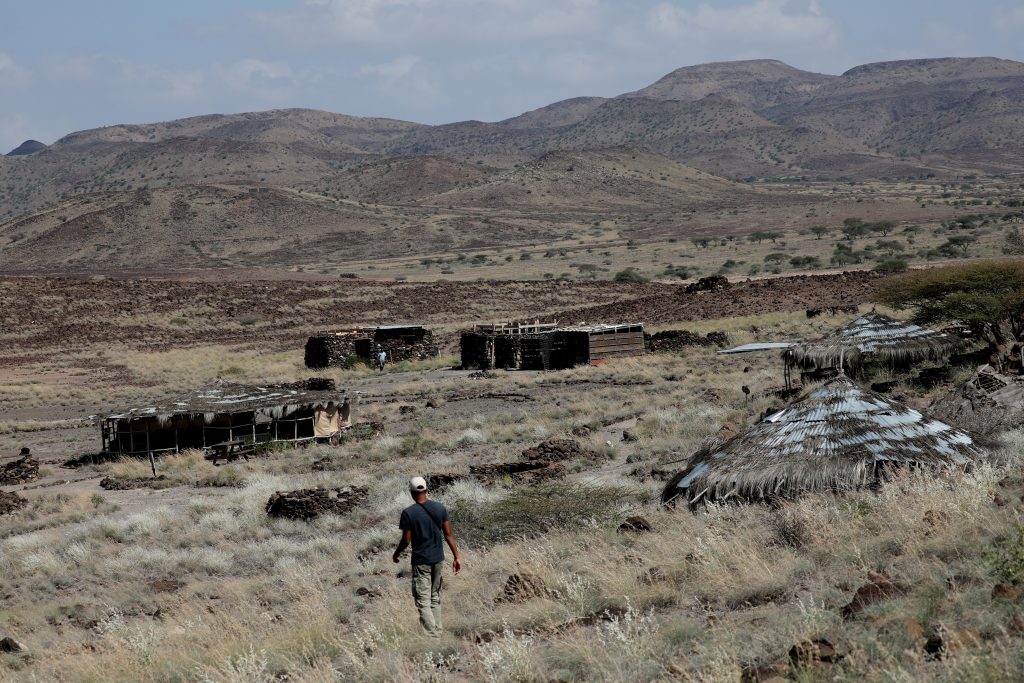
Mathieu ‘strolls’ ahead. Photo Alex Meyer.
A hike up the ridge on the other side of camp revealed Speke’s Pectinators and Rock Hyraxes.
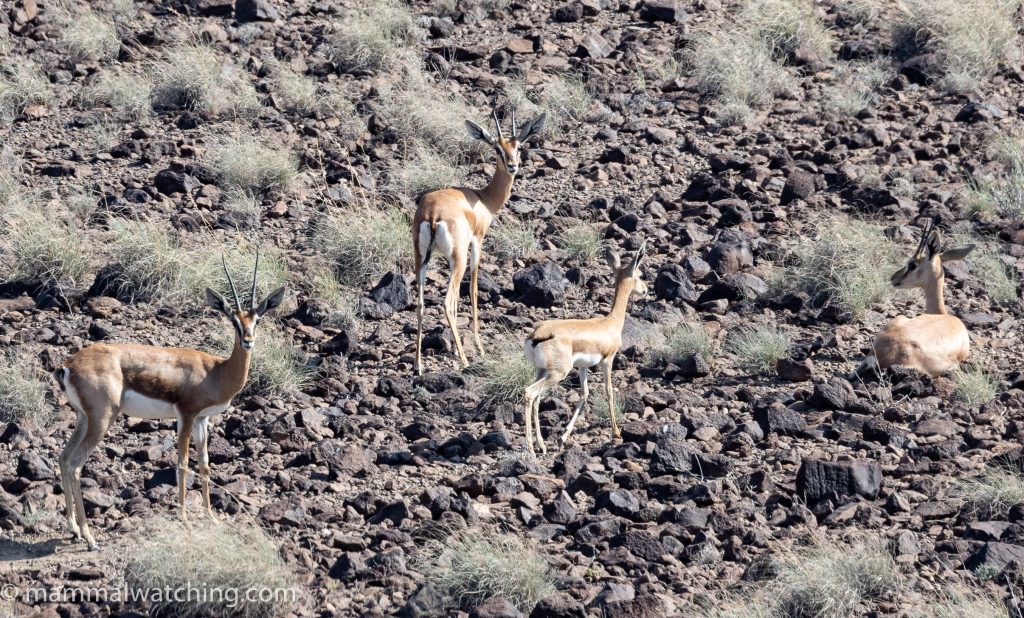
Dorcas Gazelle (Gazella dorcas)
We did a drive in the reserve, seeing Gerenuk and Salt’s Dik-dik, then left the reserve about 11:00 am. Back on the main road we saw one male Soemmerring’s Gazelle and several more Dorcas Gazelles.
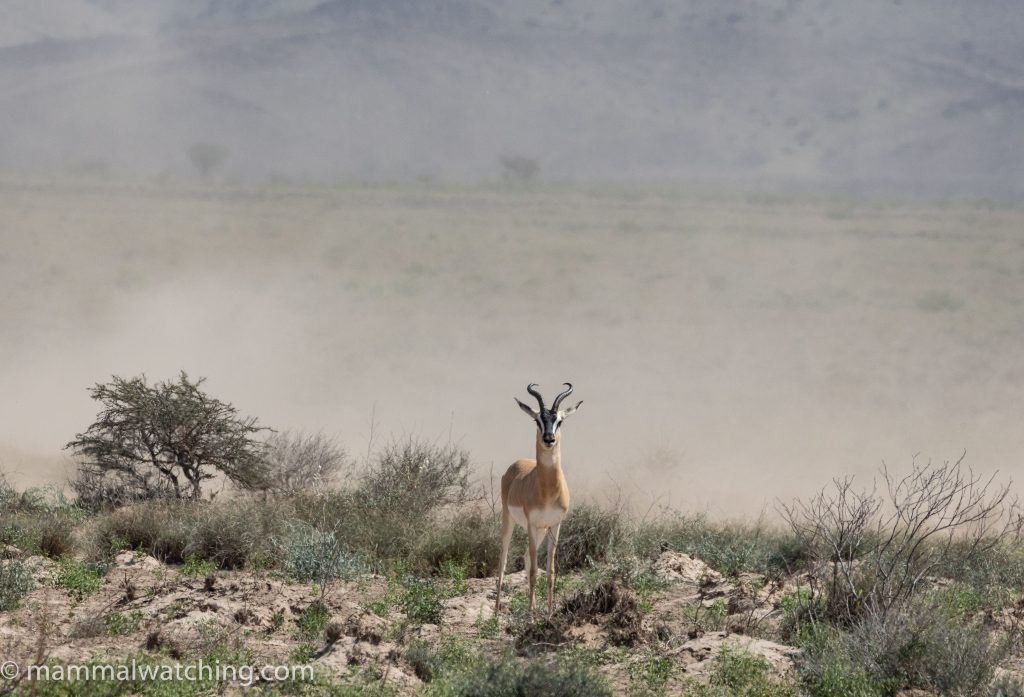
Soemmerring’s Gazelle (Nanger soemmerringii)
We stopped at La Palmeraie Hotel for lunch and, shortly afterwards, left the asphalt on one of the roughest and rockiest roads I’ve ever experienced. Reaching a dry stream bed for the last part of the drive was a welcome relief in comparison.
Assamo
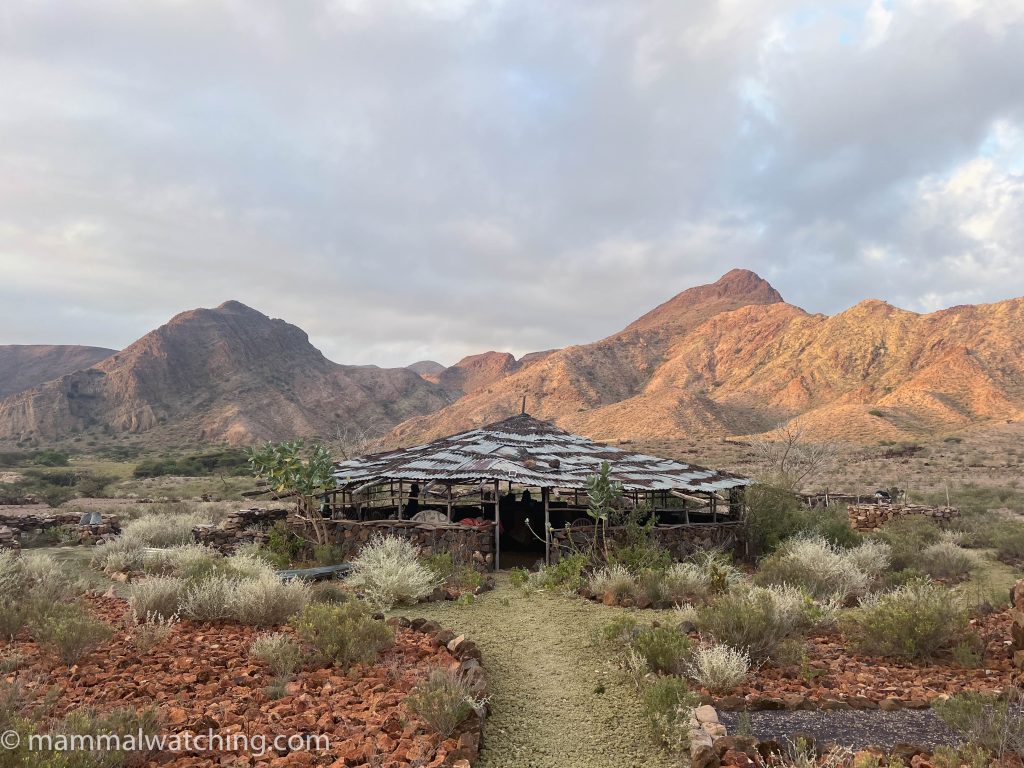
There was, however, one great compensation for the drive – Assamo camp. We had been told that the camp had been destroyed in storms and was unusable. Perhaps we have exceptionally low standards but I think all of us thought the camp was great. Low-roofed stone structures similar to Djalelo in an amphitheatre of low mountains and with an unmatched feeling of tranquility.
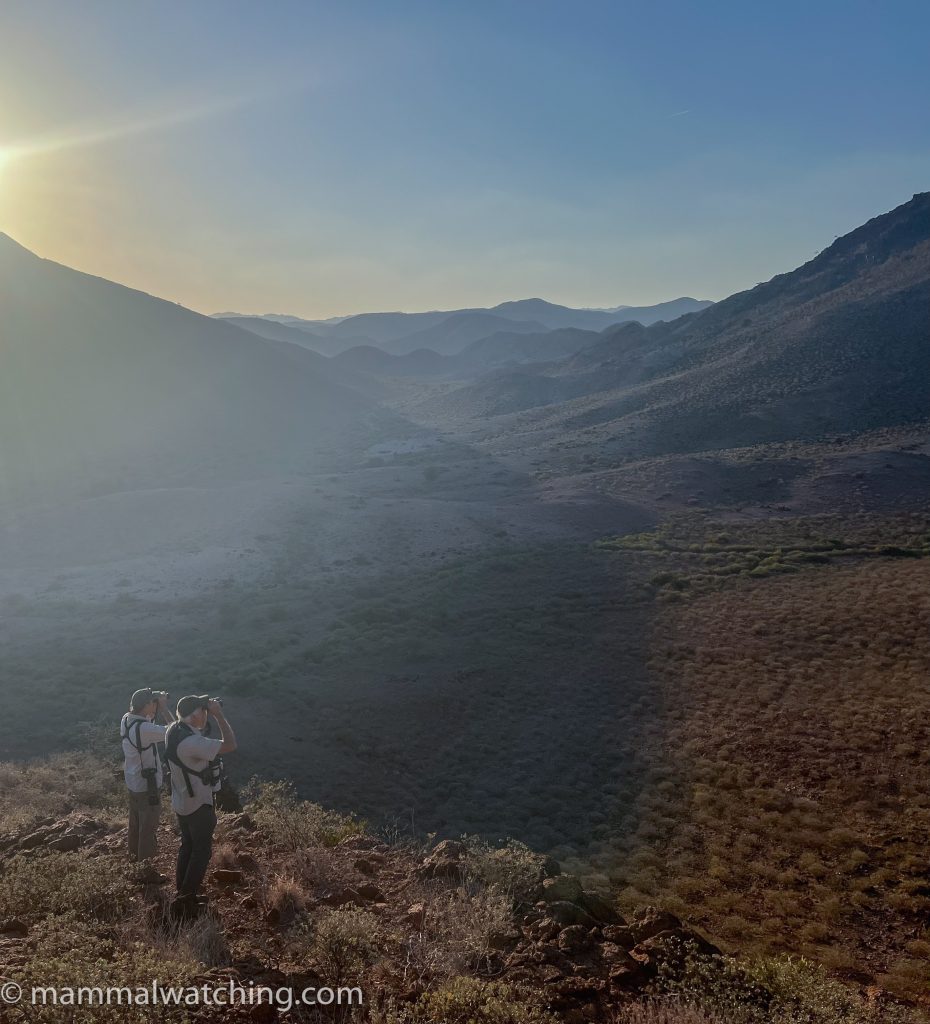
Mathieu had visited several times in the past and suggested a hike into the hills. Forty-five minutes later, we were looking at three Beira silhouetted against the ridgeline, one of our most hoped-for targets in Djibouti.
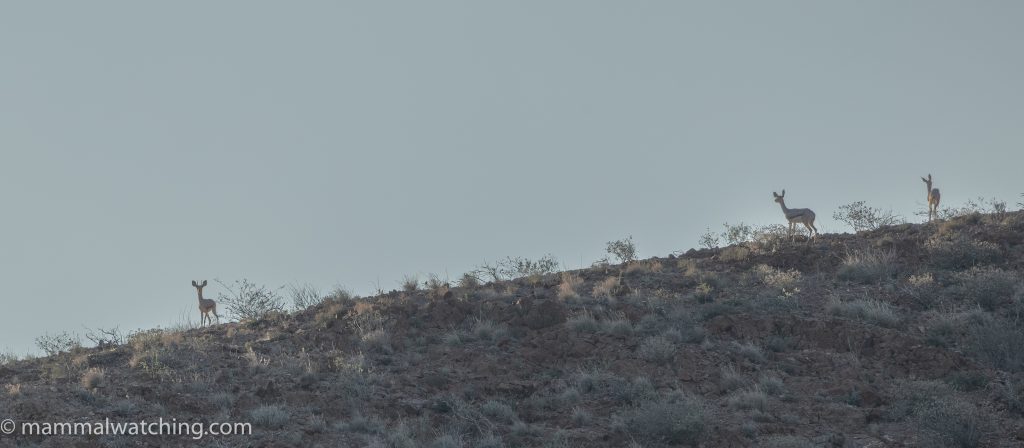
Beira (Dorcatragus megalotis)
We continued over the ridge and got some closer views. Feeling triumphant, we climbed to the height of land for views over the border with Somaliland.
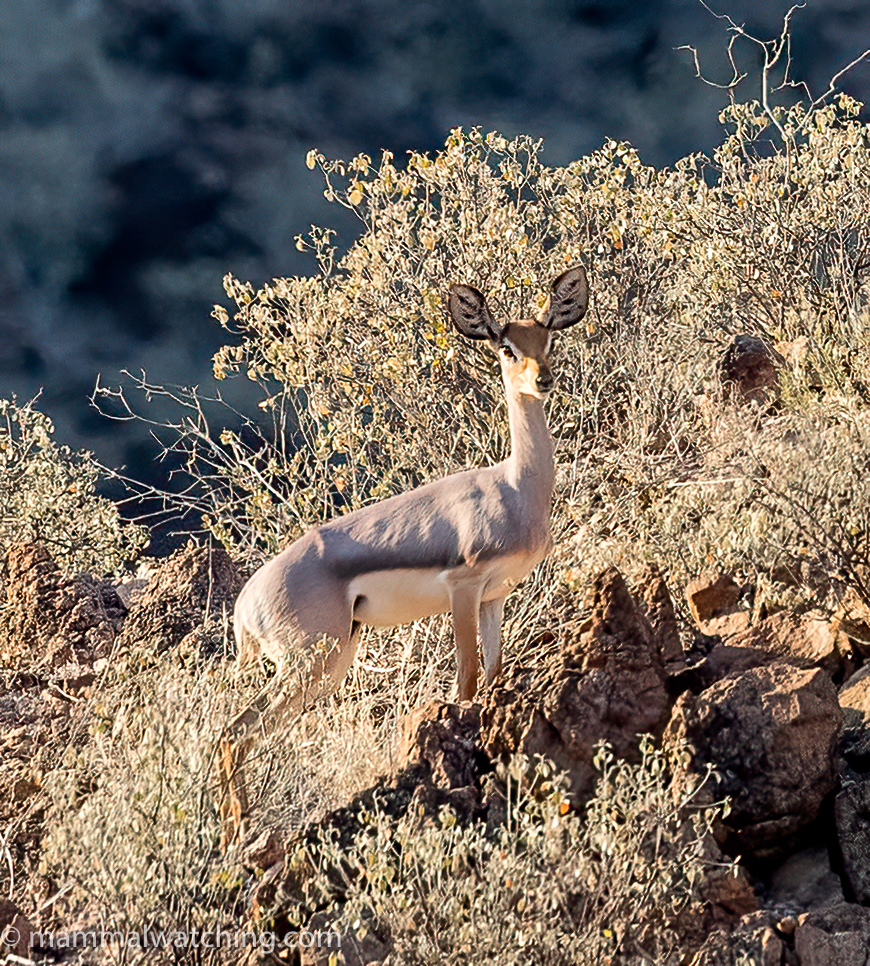
Beira (Dorcatragus megalotis)
On the return trip we saw several Speke’s Pectinators.
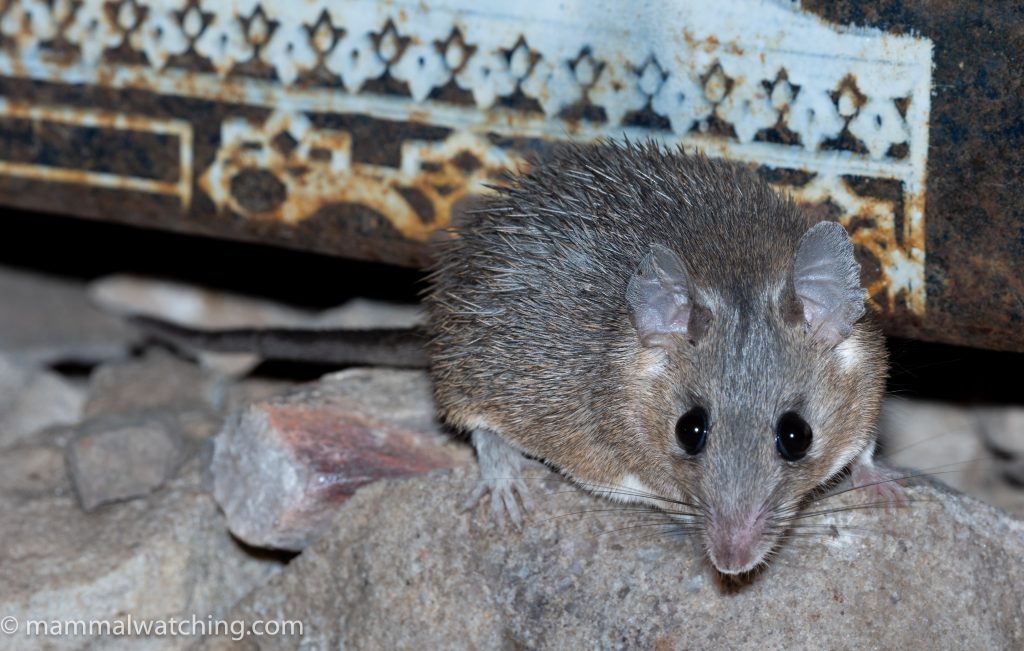
Mullah Spiny Mouse (Acomys mullah)
Charles had arrived back in camp first and was taking pictures of two species of spiny mice in the dining area. Bait was put out to encourage them to return for pictures.
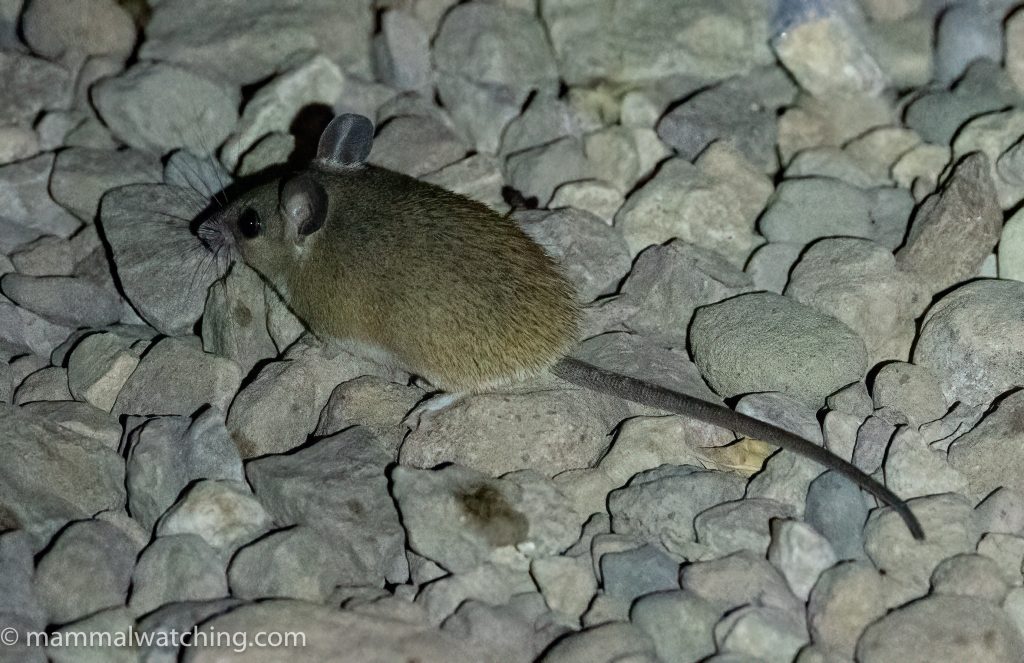
Louise’s Spiny Mouse (Acomys louisae)
(NB. Jon : Thank you Venkat Sankar for the ID help!)
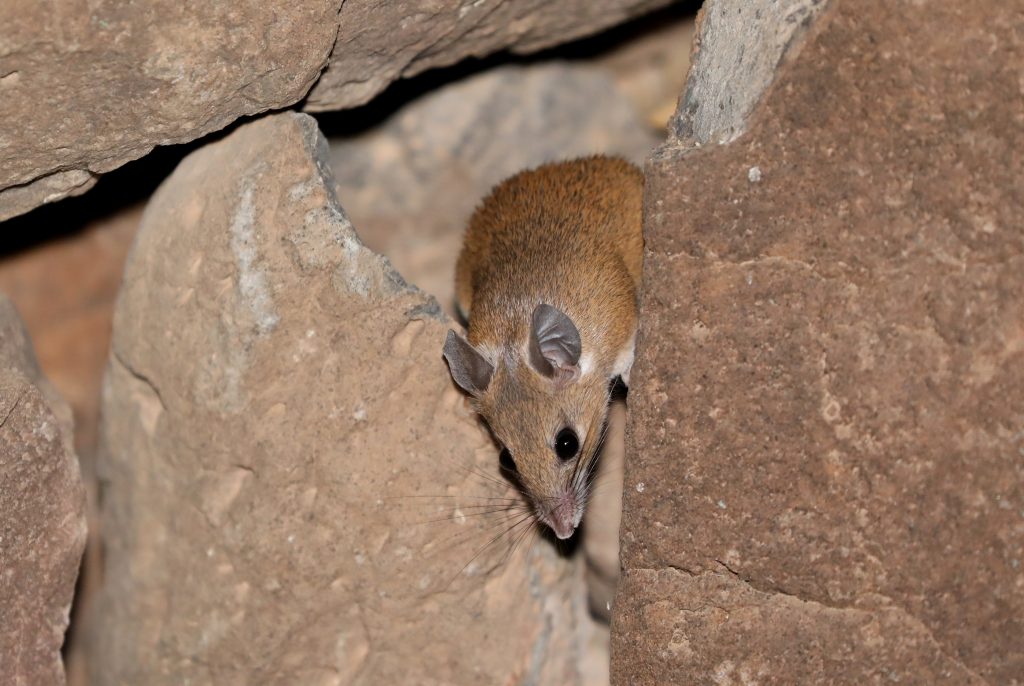
Louise’s Spiny Mouse (Acomys louisae). Photo Alex Meyer
A night walk produced sightings of Salt’s Dik-diks, a distant Ruppell’s Fox, a Heart-nosed Bat and Abyssinian Hare. We were back by 9:30, all feeling tired but elated.
The next morning started with a walk to look for sengis along the dry riverbed near camp.
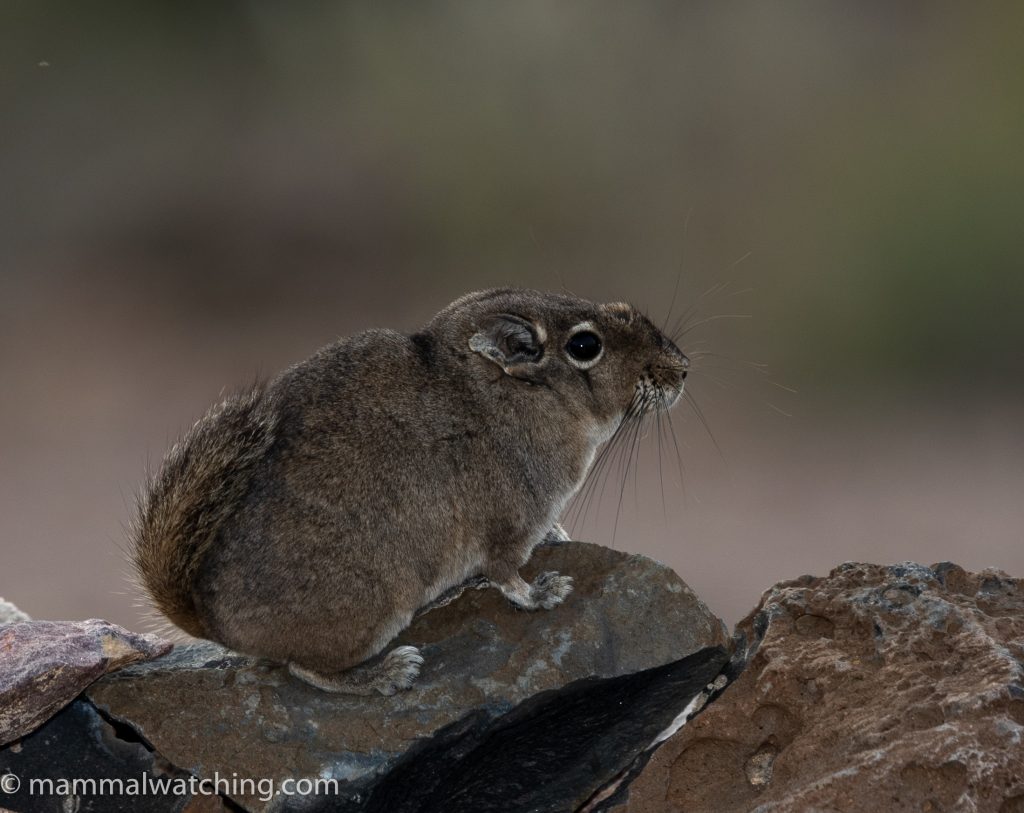
Speke’s Gundi or Pectinator (Pectinator spekei)
We saw several Speke’s Pectinators but unfortunately no sengis.
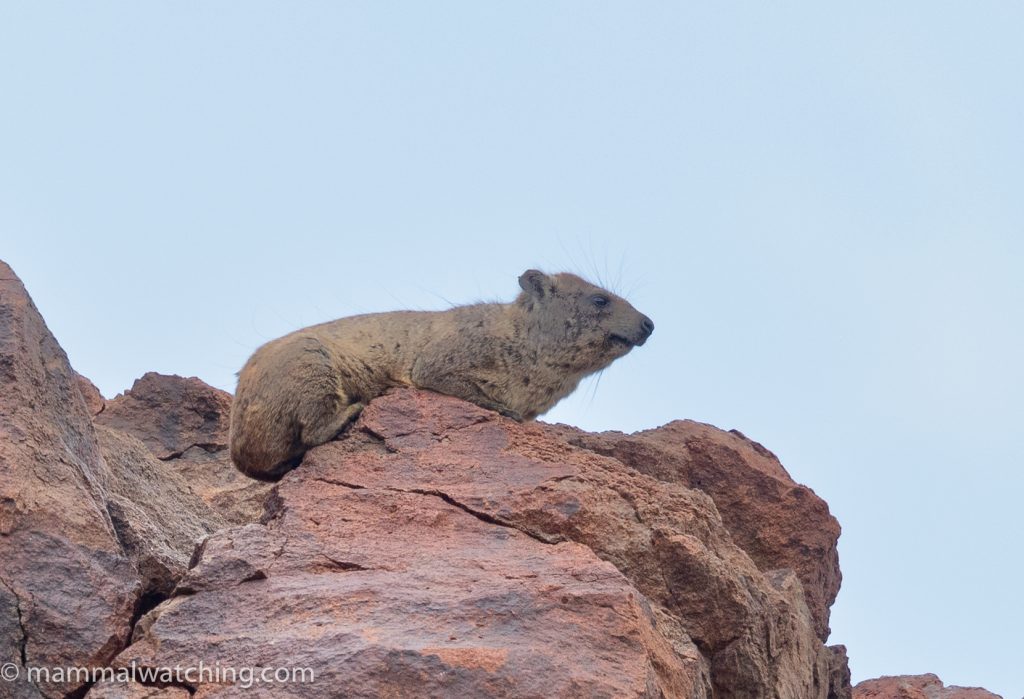
Rock Hyrax (Procavia capensis)
After packing up, we hiked up to a cave reputed to contain bats, seeing more pectinators and several Rock Hyraxes on the way.
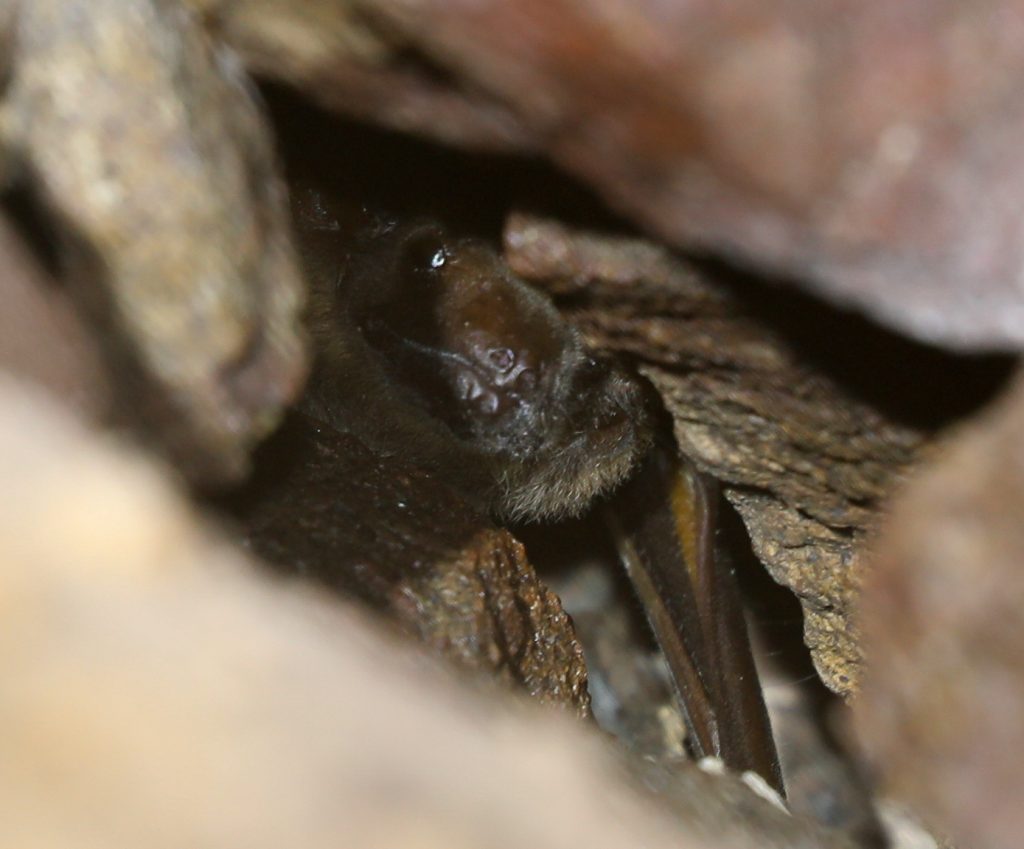
Egyptian Tomb Bat (Taphazous perforatus) possibly. Photo Alex Meyer.
We had poor views of what was likely an Egyptian Tomb Bat, then headed back to La Palmeraie for lunch and on to Dittilou camp.
Dittilou Camp
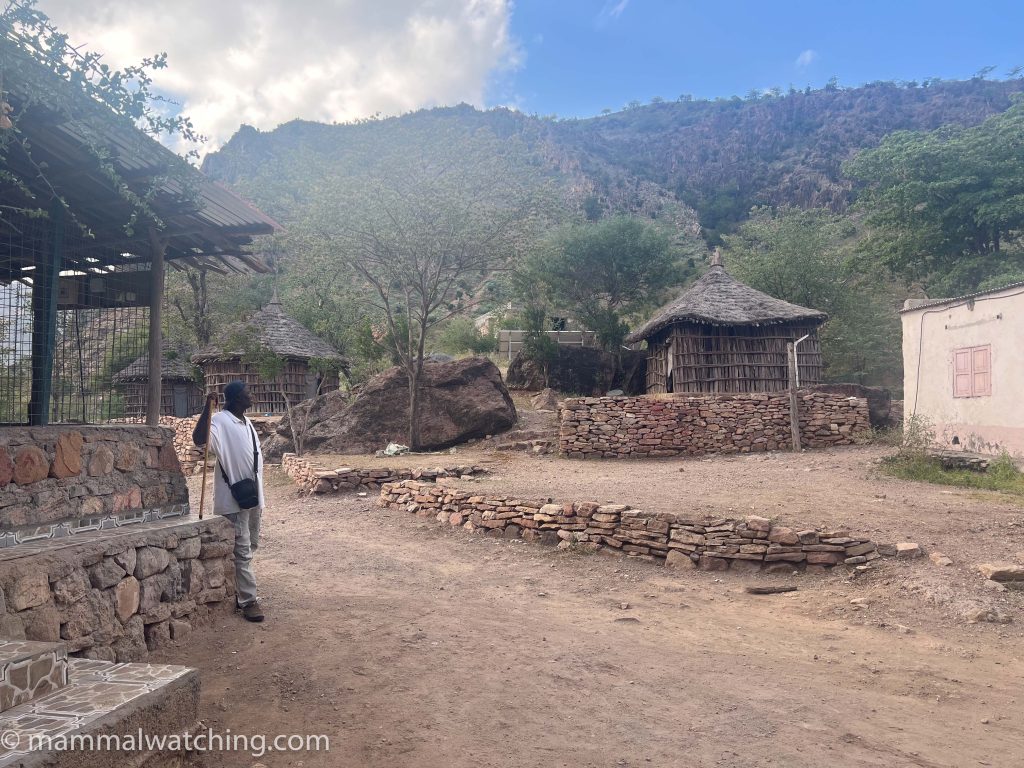
At first glance, Dittilou Camp is uninspiring. The dining tables are enclosed in wire, giving a caged-in vibe, and garbage is strewn around everywhere. The contrast with Assamo Camp is extreme.
We spoke with a local guide, Said, who stated that both Common and Abyssinian Genets occurred around the camp as well as Maned Rats, which cheered our spirits considerably. After supper we walked out to the garbage tip behind the buildings and immediately saw a White-tailed Mongoose which climbed up the ravine but returned several times later that evening.
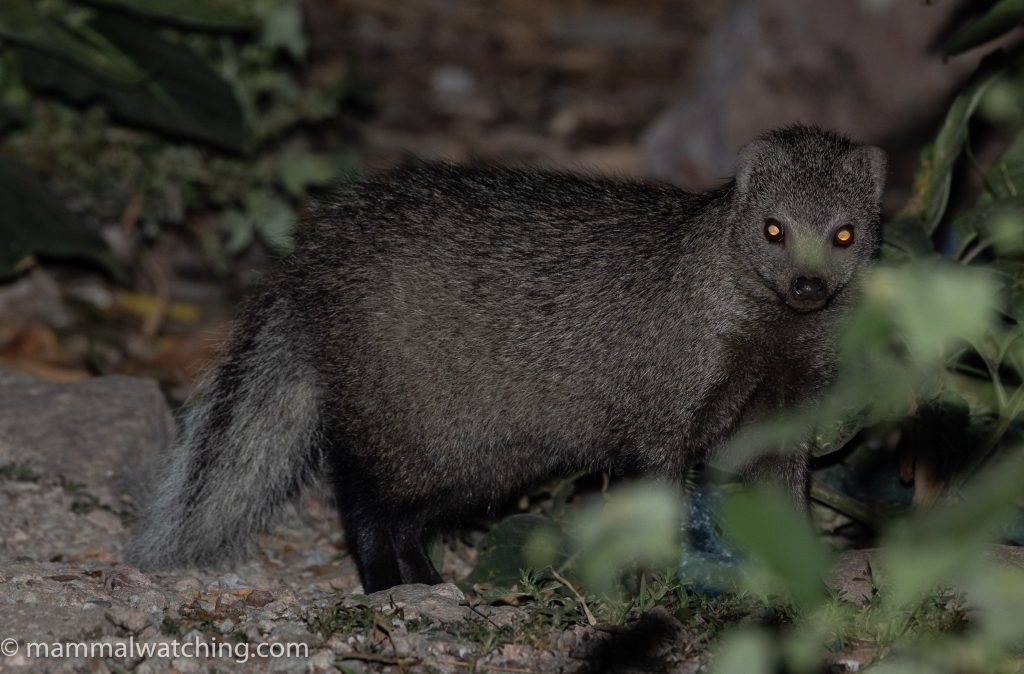
White-tailed Mongoose (Ichneumia albicauda)
Shining the lights around, we spied a genet at the base of a tree. Charles moved closer to it and confirmed that it was an Abyssinian Genet, while Mathieu and Alex tried to follow it for closer views while it moved away. We then got a call from the staff that there was a Maned Rat in one of the nearby buildings, which Alex, Charles and I ran over to see. Back at the kitchen area, White-tailed Mongooses and another Maned Rat provided good views.
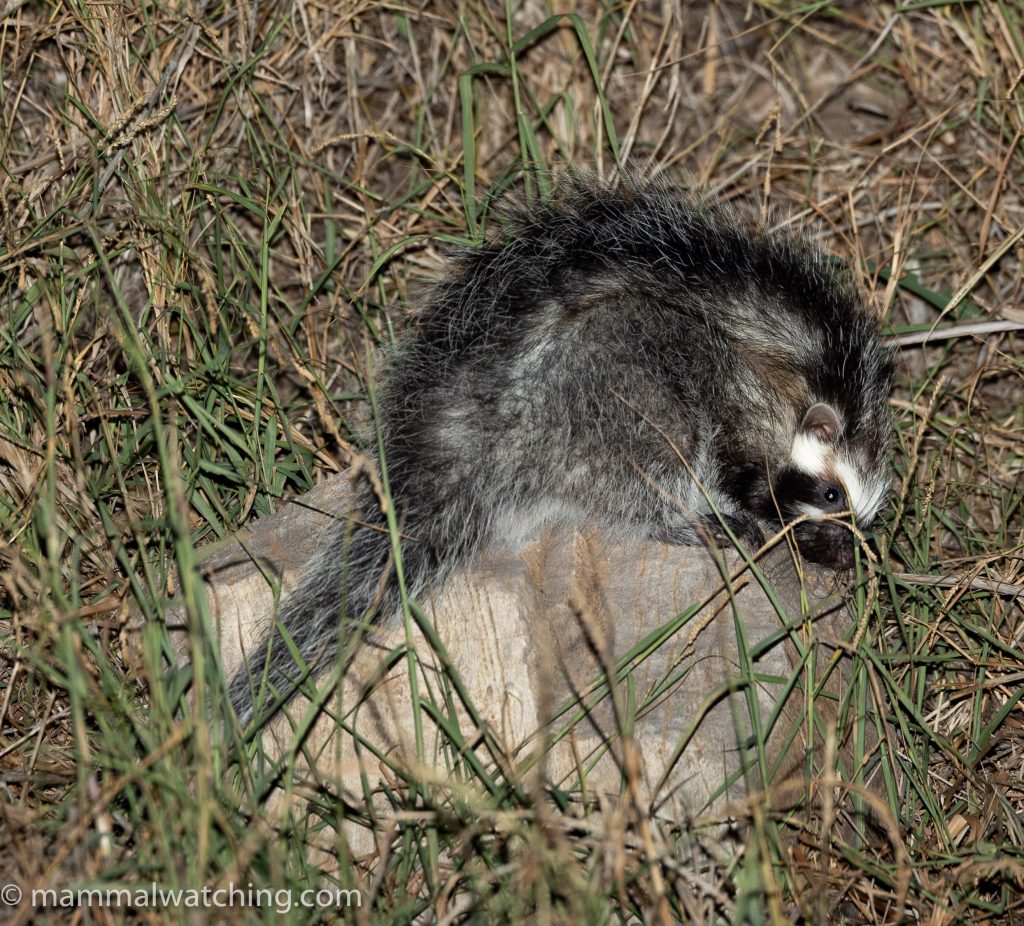
Maned Rat (Lophiomys imhausi)
After a while, I hiked up the streambed and saw a black and white animal that I was sure was a Striped Weasel, followed by two Klipspringers. I announced my “weasel” sighting to Charles and Jon. After Charles recovered from his palpitations, we checked the distribution maps and Jon gently pointed out that the animal must have been a Zorilla, as the nearest part of the distribution range of the weasels was many hundreds of kilometres away.
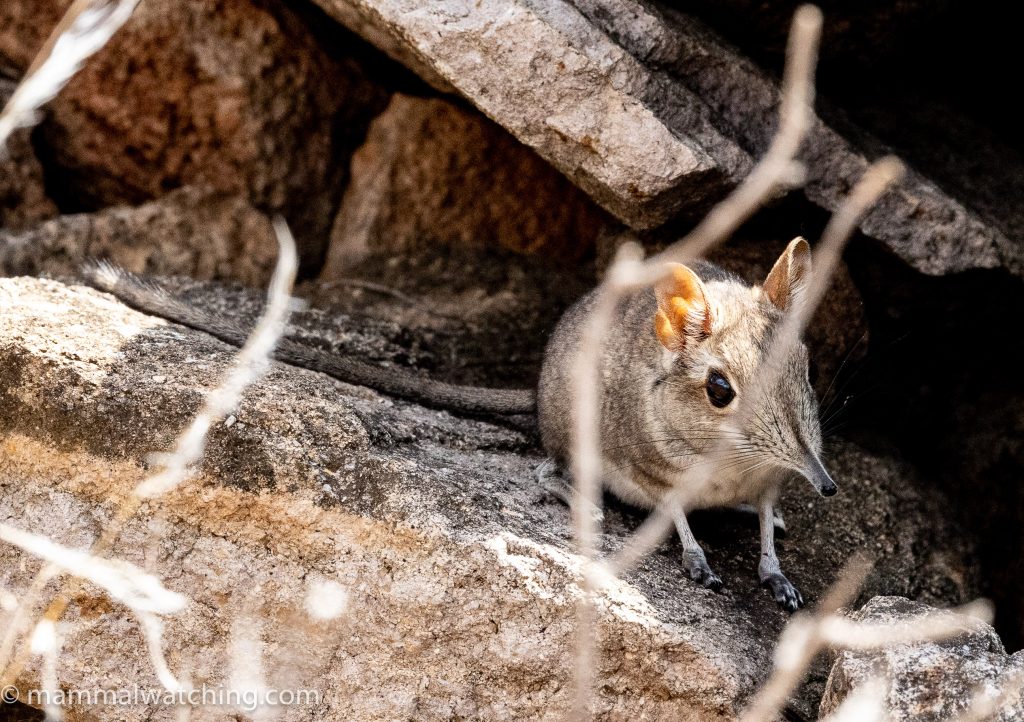
Somali Sengi (Galegeeska revoilii)
We walked to an abandoned village the next morning and were rewarded with views of two Somali Sengis, one of which posed nicely allowing photos and prolonged views.
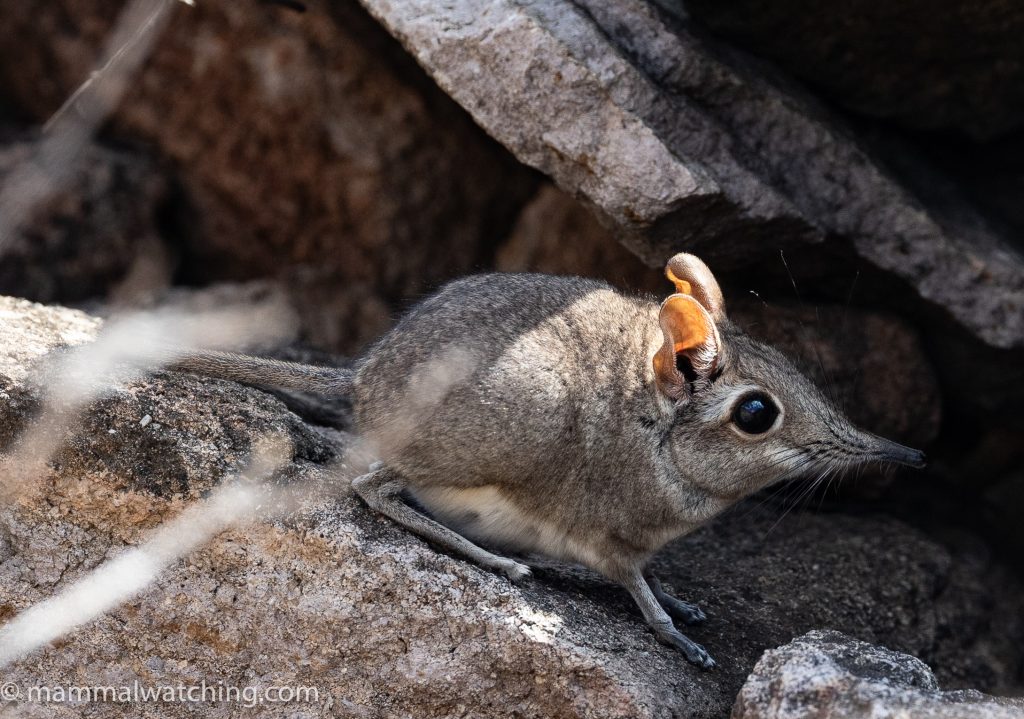
Somali Sengi (Galegeeska revoilii)
After lunch and some downtime, we hiked up into the hills above Dittilou Camp, seeing several Bush Hyraxes on the way.
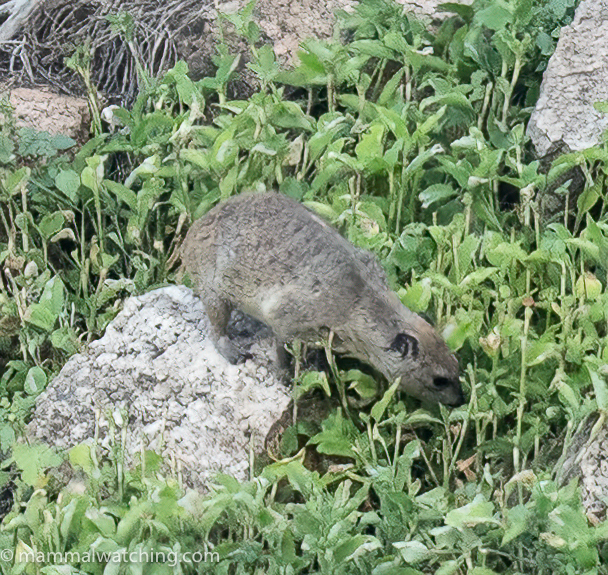
Bush Hyrax (Heterohyrax brucei)
We reached an area of forest where roosting fruit bats had been seen but did not find any ourselves.
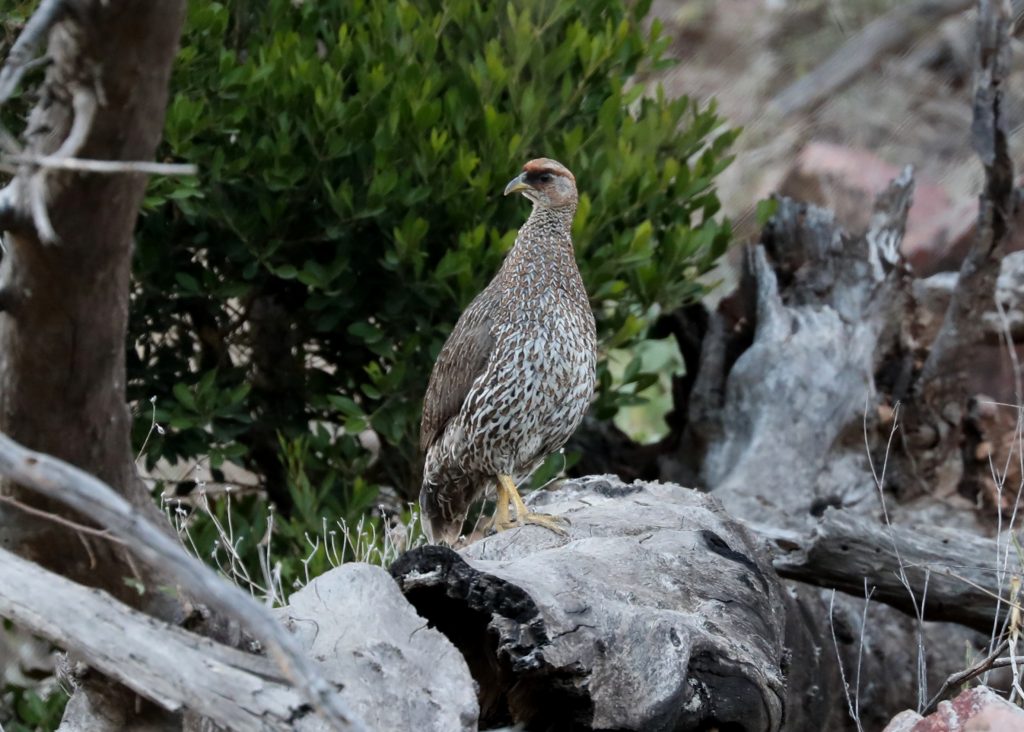
Djibouti Francolin. Photo by Alex Meyer, who ought to have been looking for bats rather than taking this in my opinion!
We did see a Djibouti Francolin, the only bird endemic to the country.
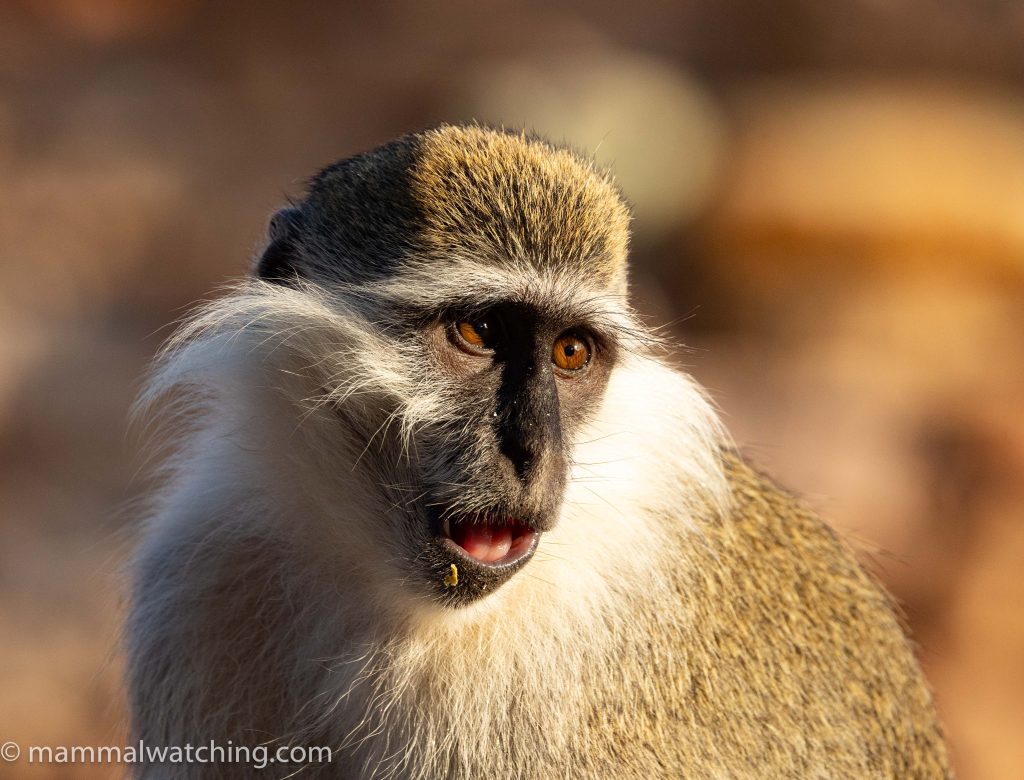
Grivet Monkey (Chlorocebus aethiops)
After a dinner of beef kebabs and salad, we returned to the area behind the kitchen and soon saw another White-tailed Mongoose. We hiked up the draw behind the camp and found an Abyssinian Genet deep in a thicket of vegetation. We had several brief but reasonable views before it disappeared.

Abyssinian Genet (Genetta abyssinica)
Meanwhile, Mathieu had located the Abyssinian Genet again, which would appear briefly, then resume heading up the hillside.
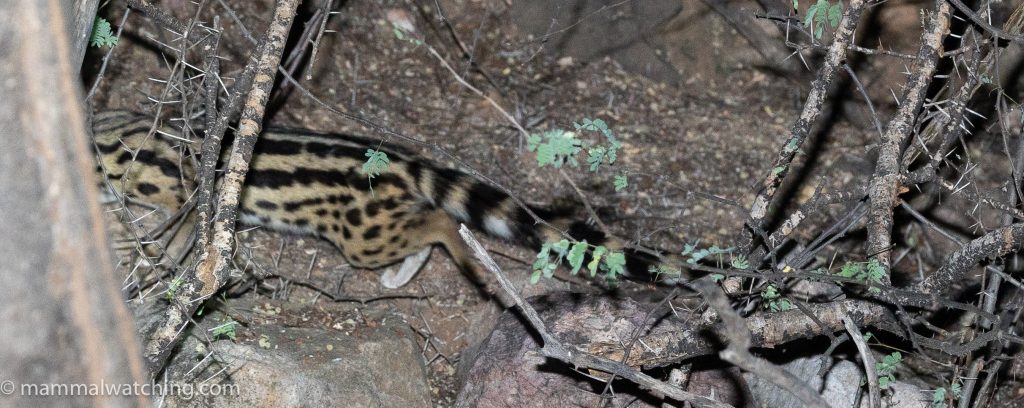
Abyssinian Genet (Genetta abyssinica)
We eventually got to a spot where we had clear views of the genet across a ravine, although I had set my camera to manual and managed to take some incredibly dark photos. Fortunately, others in the group got better photos. After a brief stint back at the kitchen, I headed out again and managed to find a Common Genet, which was distinctly different in both appearance and behaviour and far easier to photograph.
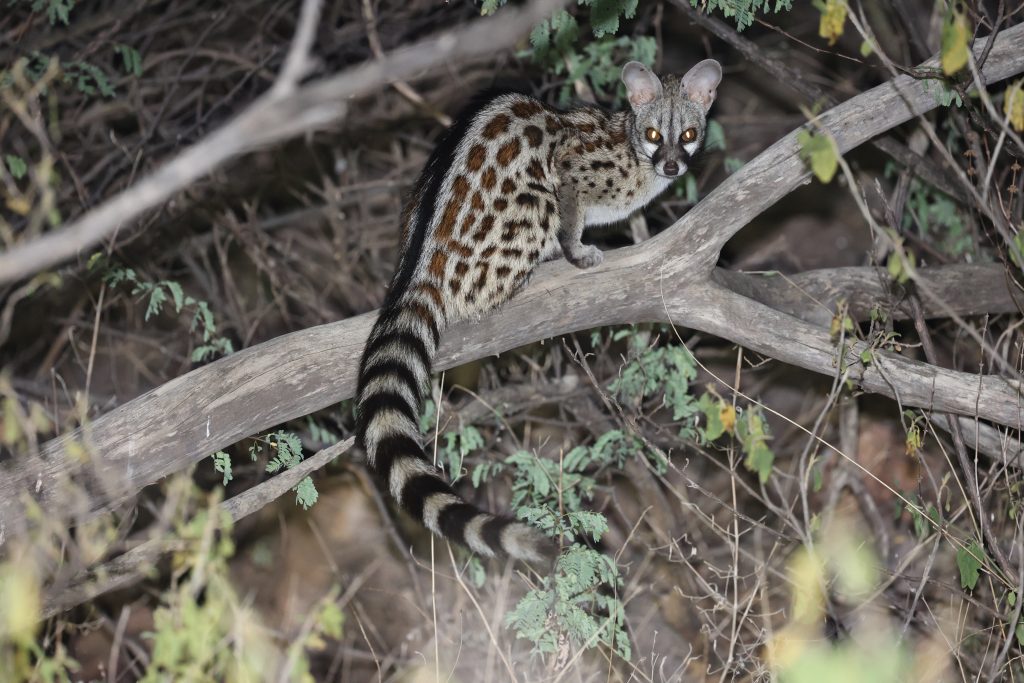
Common Genet (Genetta genetta). Ian Thompson
The next morning, Alex and Mathieu went out looking for the Klipspringers while the rest of us linger over coffee. They saw no Klipspringers but did see a Slender Mongoose. We left Dittilou about 9:40 and drove back to Djibouti City, seeing a troop of Hamadryas Baboons along the way. One of the large males jumped on the hood of the vehicle and defecated, clearly letting us know what he thought of us. We arrived in the city about 2:30 and headed to the Acacias Hotel for beer and pizza before getting ready for our flights home.
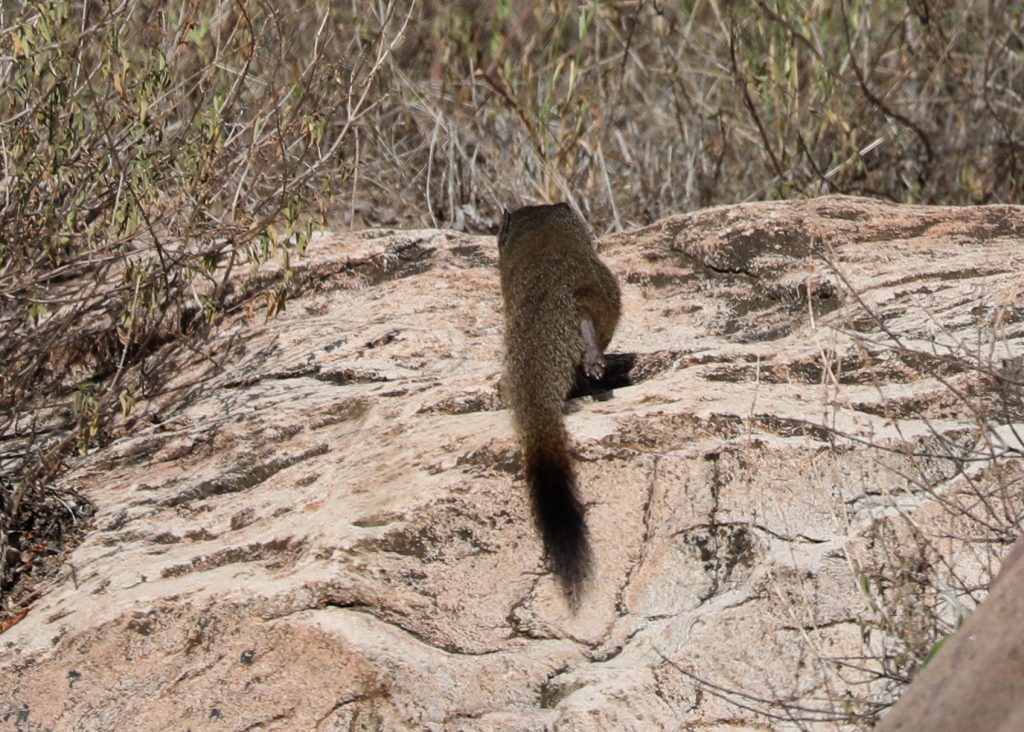
Common Slender Mongoose (Herpestes sanguineus), Photo Alex Meyer.
Djibouti was a revelation for me. I had expected a mundane flat desert and instead found mountains covered in xeric grasslands populated by fantastic wildlife. Our guide, Mathieu Mahamoud-Issa, was outstanding. The wildlife sanctuary for which he works, Décan, already manages several reserves in the country on behalf of the government, including Djalelo and Assamo, and may start organizing its own wildlife-focused trips in Djibouti. Louback Hamadou, our driver, owns a couple of vehicles, knows the country intimately and provided exemplary service. May many more wildlife enthusiasts visit this spectacular country.
Ian Thompson
Victoria, Canada
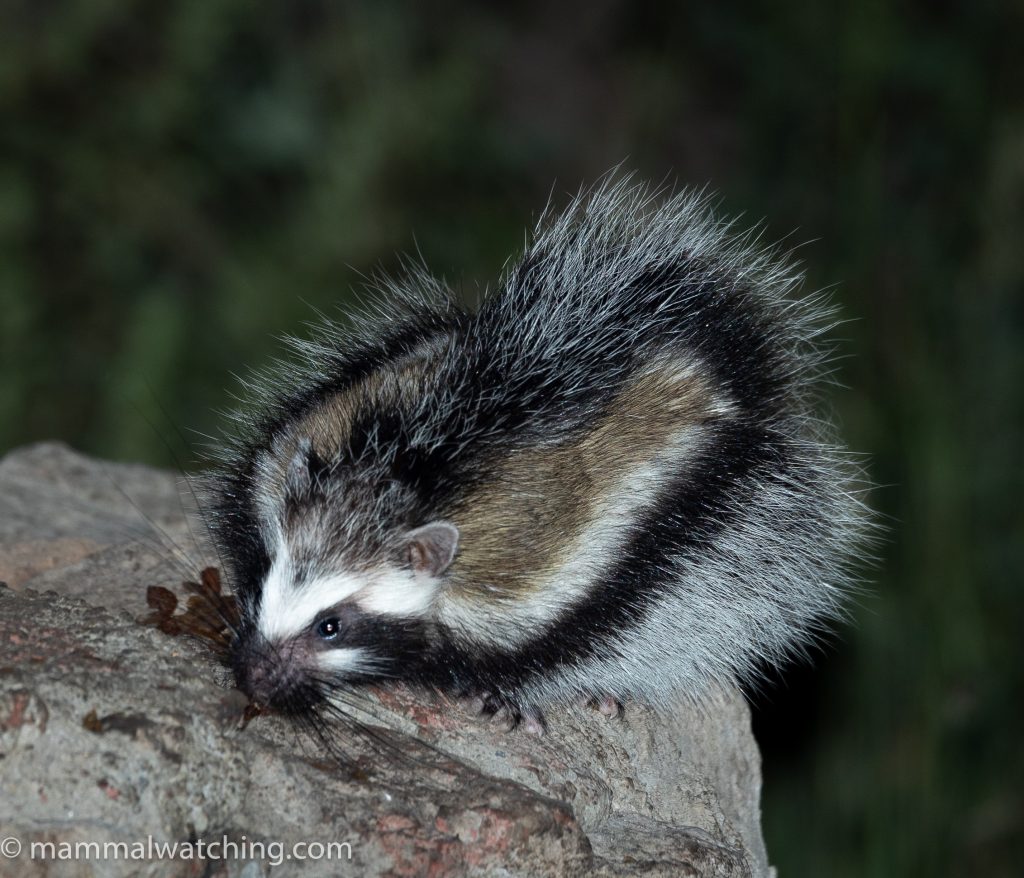
Maned Rat (Lophiomys imhausi)
Trip List
Somali Sengi (Galegeeska revoilii)
Bush Hyrax (Heterohyrax brucei)
Rock Hyrax (Procavia capensis)
Grivet Monkey (Chlorocebus aethiops)
Hamadryas Baboon (Papio hamadryas)
Speke’s Gundi (Pectinator spekei)
Crested Porcupine (Hystrix cristata)
Louise’s Spiny Mouse (Acomys louisae)
Mullah Spiny Mouse (Acomys mullah)
Maned Rat (Lophiomys imhausi)
Ruppell’s Fox (Vulpes rueppellii)
Zorilla (Ictonyx striatus)
Common Slender Mongoose (Herpestes sanguineus)
White-tailed Mongoose (Ichneumia albicauda)
Abyssinian Genet (Genetta abyssinica)
Common Genet (Genetta genetta)
Egyptian Tomb Bat (Taphozous perforatus) (unconfirmed)
Heart-nosed Bat (Cardioderma cor)
Beira (Dorcatragus megalotis)
Dorcas Gazelle (Gazella dorcas)
Gerenuk (Litocranius walleri)
Salt’s Dik-dik (Madoqua saltiana)
Soemmerring’s Gazelle (Nanger soemmerringii)
Klipspringer (Oreotragus oreotragus)
24 species with 5 lifers for Jon (in bold).
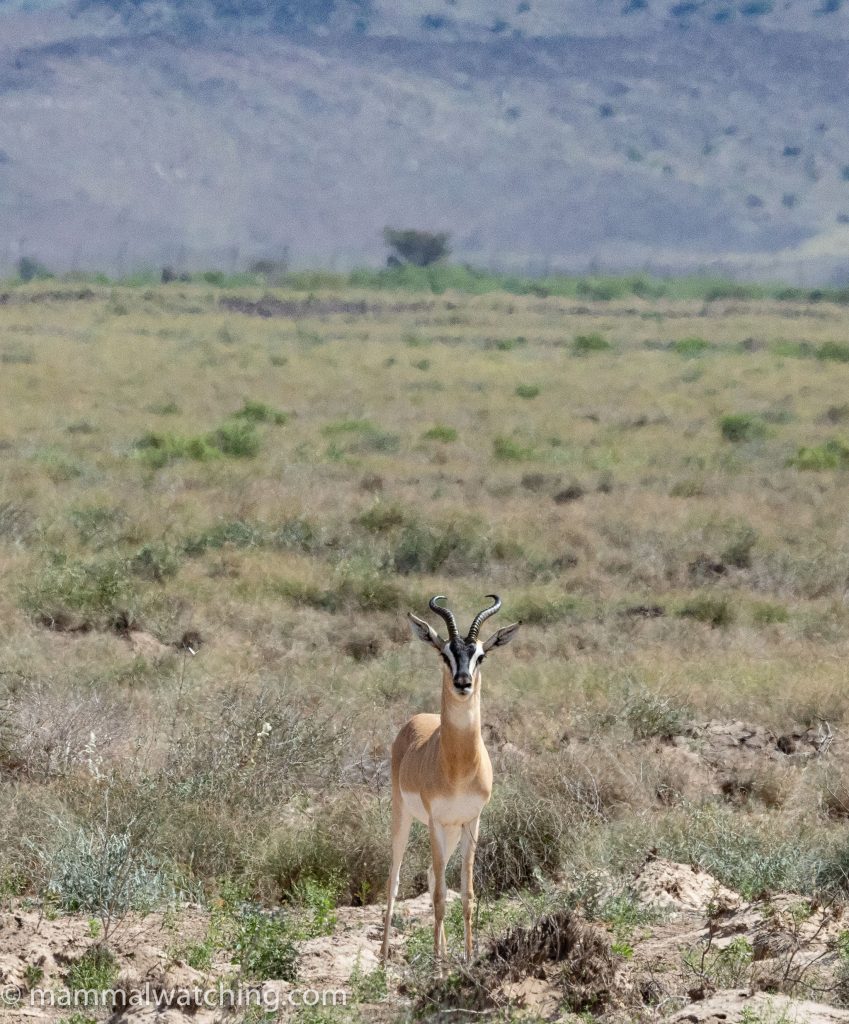
Soemmerring’s Gazelle (Nanger soemmerringii)
Post author
4 Comments
-
-
JanEbr
I’ve said it on FB and I’ll sat it here: shame on us for not beating you to it! We were really thinking about Djibouti, but then dismissed it as “probably not very interesting” …. what fools we were. And now it has no point since it has been already explored 🙂 Well, that’s enough commenting for now, we go to eat some fish!
Leave a Reply
You must be logged in to post a comment.

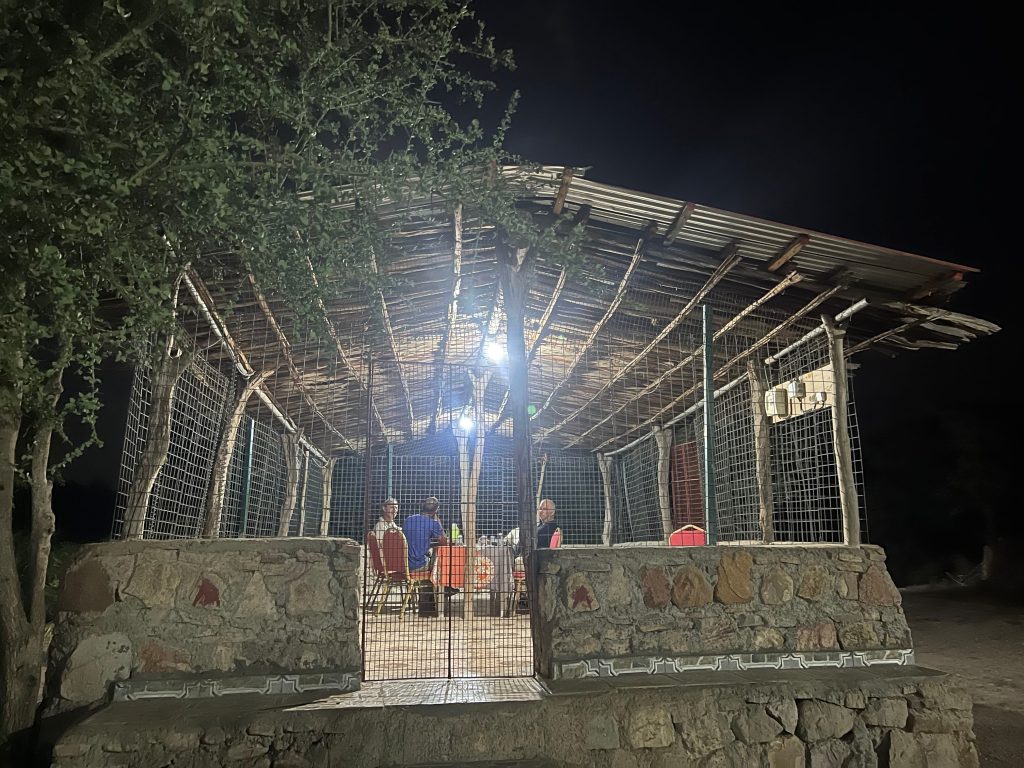
gaeaston4
Fascinating trip! I’m in the no fish crowd too so appreciate the frustration!